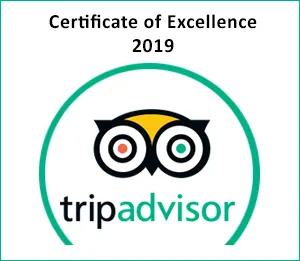The Best Luxury Tour of Myanmar, Vietnam and Cambodia
- 22 Days
Day 1: Arrive in Yangon, Myanmar. Your arrival and departure transfers can be reserved with your guest relations manager, who is assigned to you after you book your tour. We strongly recommend that our guests consider arriving a day earlier, as this allows you to recuperate from jetlag, and serves as insurance against international flight delays and cancellations.
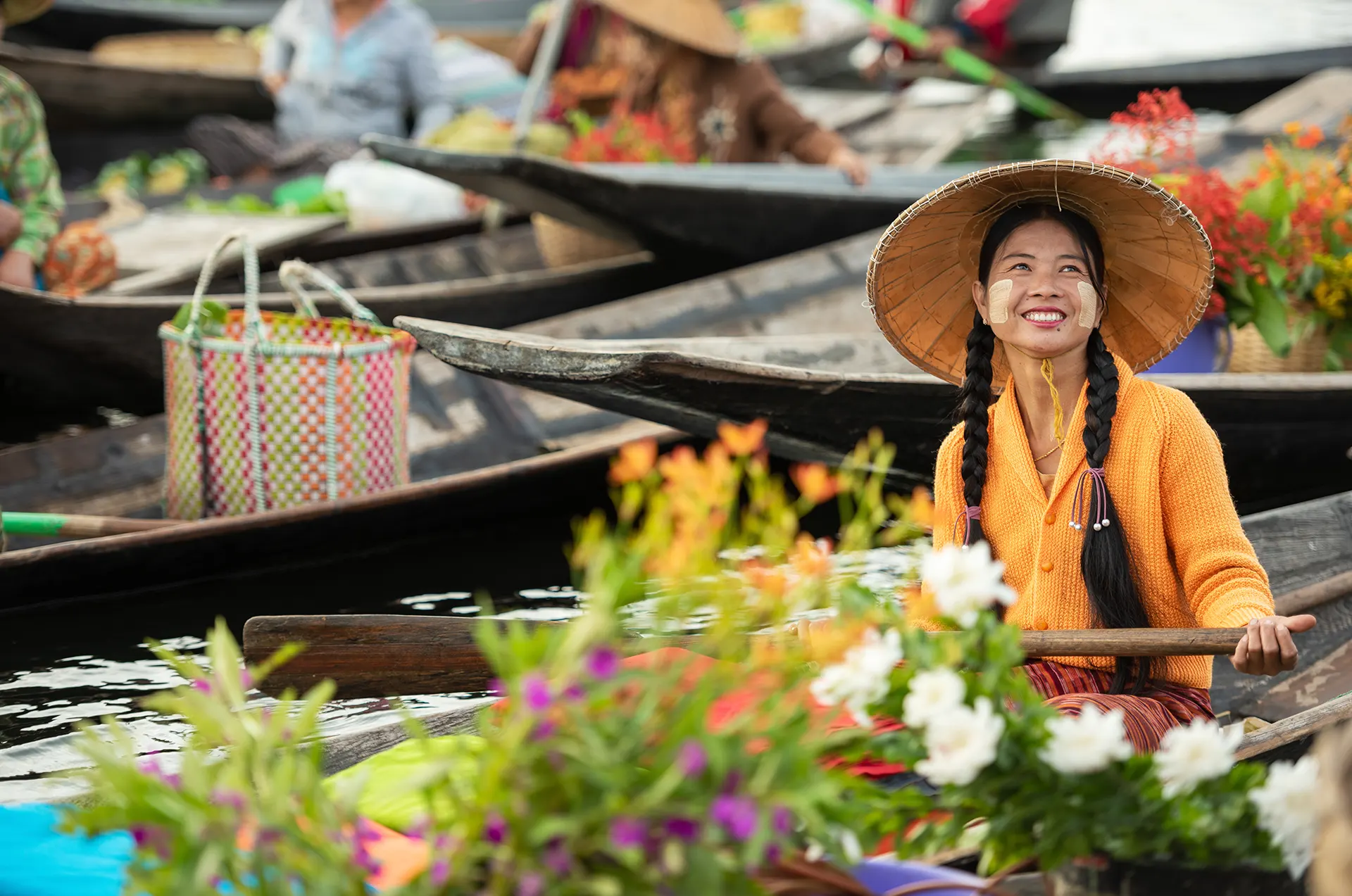
Lady with Thanaka on her Cheeks
An additional night’s lodging at the luxury and historic Rosewood Yangon, the city’s best hotel, can be added as part of the process as you reserve your tour.
If you are arriving a day earlier, your airport to hotel transfer will be provided a day earlier. Our services begin with your luxury VIP greeting as you disembark at Yangon airport. You are greeted as soon as you exit your plane and you will now be escorted through the complete arrival process, including immigration, baggage claim, and customs, and then you will be met by your Travel Facilitator or your Accompanying Myanmar Tour Director. You are then driven to your impeccably restored historic riverfront hotel where you will check-in if it is after 3pm. If your arrival is before 3pm, you can drop your bags off and use the facilities to freshen up, unless you have requested an additional day’s stay.
Welcome to Myanmar, an ancient land with a unique culture, although things are changing fast as the country rapidly grows and evolves, now that the international trade and travel restrictions have been lifted. In the last decade we have seen an incredible amount of development occur in Myanmar, yet the nation still retains a lot of its original charm. It is home to some of the warmest people in the world, and their colorful attire and culture are fascinating to experience.
Myanmar’s biggest city, Yangon (Rangoon), is very different from most of the rest of the country, as it has rapidly progressed and expanded over the last few years. Much of what you will witness is typical of a big Southeast Asian city, with scores of tall commercial and residential buildings, traffic jams, and luxury stores. The wealthier locals lead modern and cosmopolitan, lives, yet everything is still indelibly mixed with their ancient culture and traditions.
Day 2: Yangon. (Breakfast) Begin your exploration of the Yangon region in the historic downtown area of Yangon, where you will enjoy an easy walking tour in the heart of the capital city. You will learn about the history of Yangon and the numerous colonial buildings that you are passing.
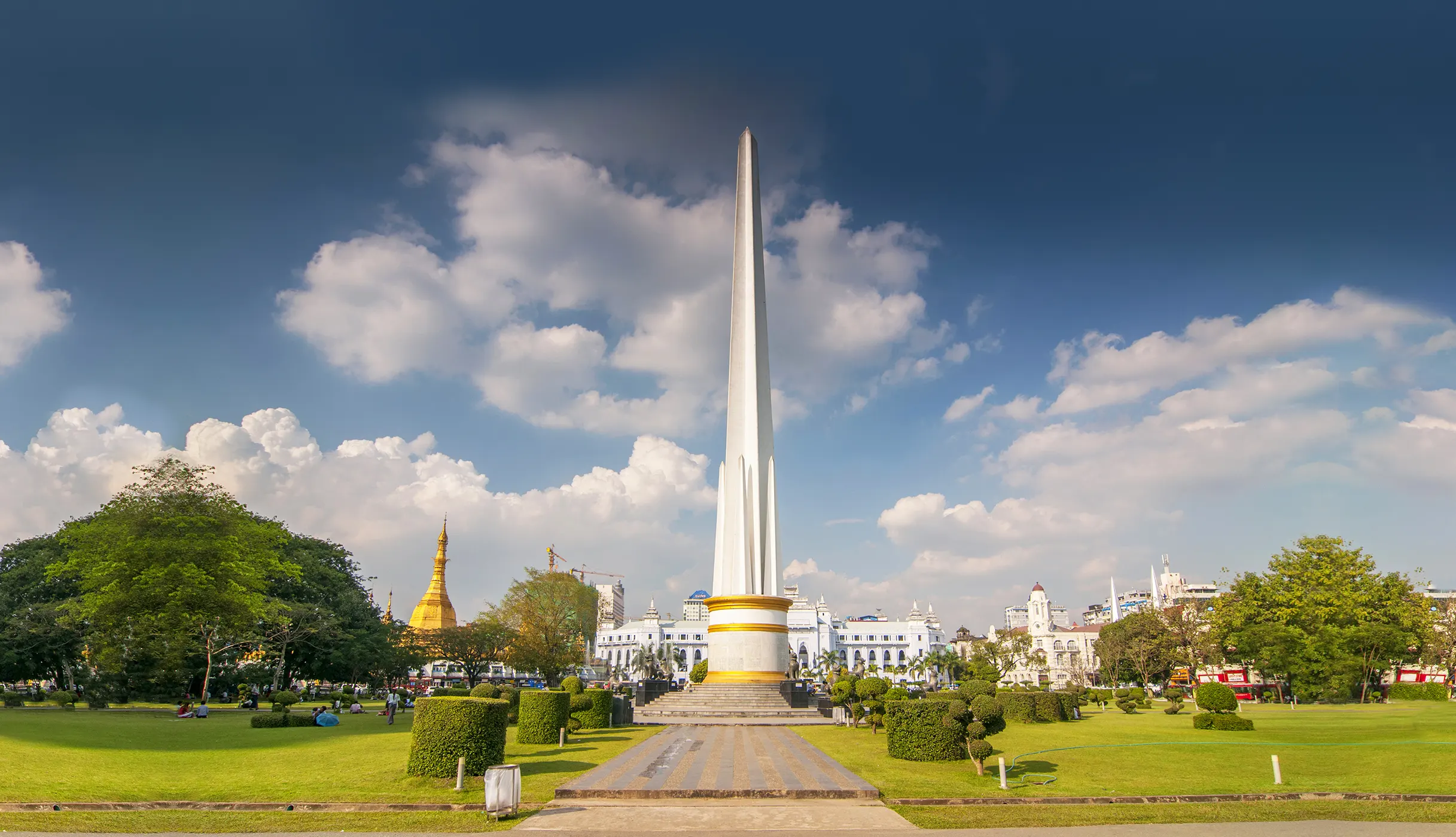
Independence Monument with City Hall & Sule Pagoda
Among others, attractions during this exploration will include the beautiful Saint Mary’s Cathedral with its exquisite collection of stained-glass windows, Sule Pagoda, Yangon’s City Hall, and Myanmar’s Independence Monument.
From here you can either drive or choose a 20-minute walk on interesting streets to the Botataung Pagoda. Located on the Yangon waterfront, this pagoda is where many Yangon residents come to pray. You can break for an early lunch now (your hotel and the historic Strand Hotel with its restaurant are both very close by), or enjoy a late lunch after your next adventure.
Across the street from where you are is the Pansodan Jetty on the riverfront in Yangon. At the jetty you will board the Ferry to the rural Dala region, which lies across the river from Yangon. Up until a couple of years ago, this extremely interesting cruise took about 15 to 20 minutes to complete. Since the Japanese government donated 3 new cruisers to Myanmar, the journey is just a few minutes, yet it is a fascinating glimpse into the life of the homeward bound villagers who belong to your destination, the rural Dala region. Vociferous hawkers walk among the seated passengers marketing all sorts of products, from food and household items, to clothing and toys for children.
Disembark from the ferry and proceed on an extended walk through this farming region that is dotted with small villages and local markets. Those that do not feel up to the walk can ask their Tour Director to arrange one of the unique trishaws that are found all over Myanmar. Although just across the river from Yangon, this is a different world, and the locals do not enjoy the big city sophistication and relative prosperity of Yangon’s residents. You will walk on dirt trails that are surrounded by farmland, farming and fishing villages with small rustic lodging, and little markets where the locals haggle over their daily needs. Photo opportunities of genuine native moments abound during this afternoon’s expedition as this area in mostly untouched by tourism. Return to the ferry and enjoy the noisy and colorful cruise back to Yangon. If you are so inclined, you can return to your beautiful hotel to freshen up and take a short break after the rural adventure.
After this you will be driven to the massive Chaukhtatgyi Reclining Buddha. This impressive image is also an attraction for locals and Buddhist monks who come here to pray. Of particular interest are the voluminous inscriptions on the soles of the feet of the statue.
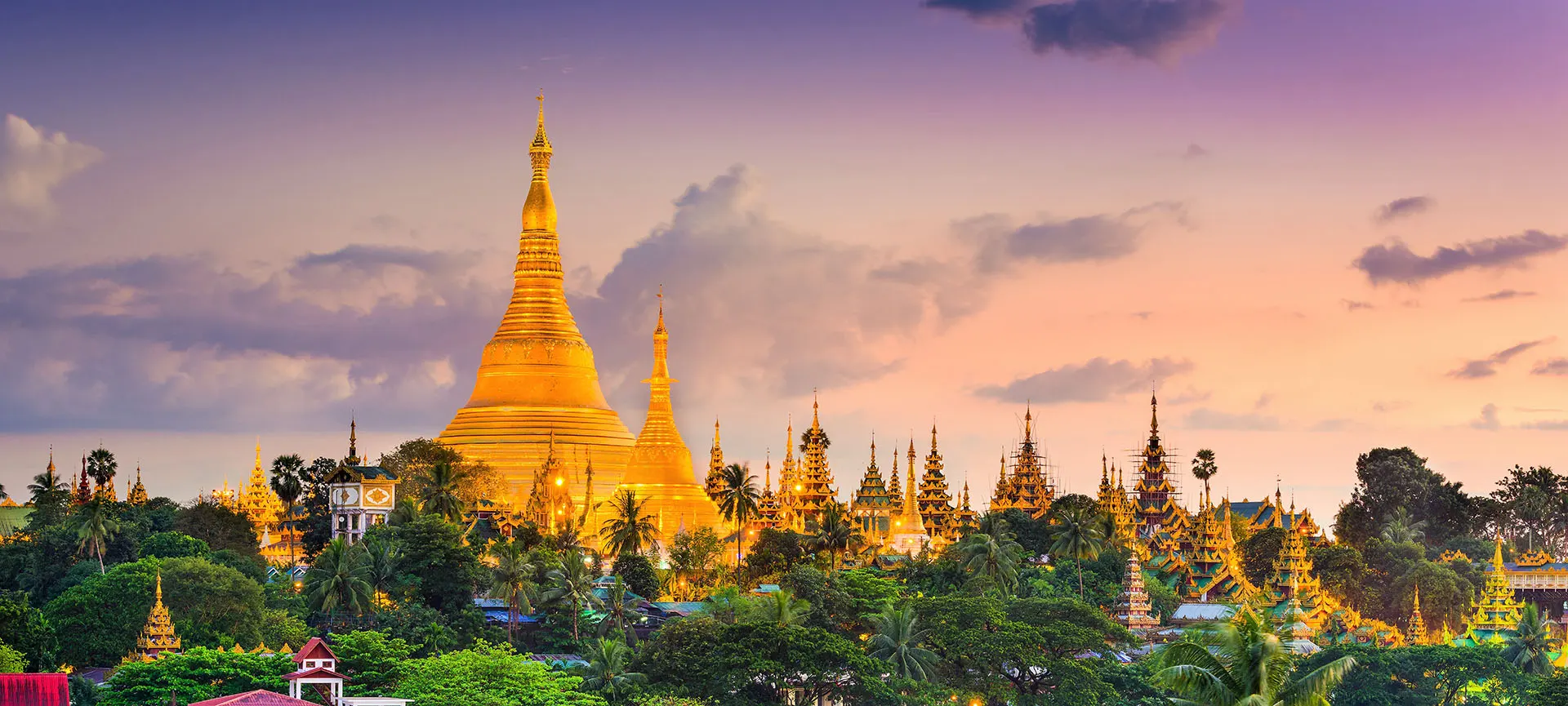
Shwedagon Stupa Complex
From here you will proceed nearby to the iconic Shwedagon Pagoda and its massive golden Stupa. This is Myanmar’s most treasured monument and you can easily spend hours exploring the various structures.
Legend has it that the Pagoda is about 2600 years old, which would make it the oldest Buddhist Stupa in the world. Academics do not agree, and date the original construction to somewhere between 600 and 1000 AD. Legend also states that the Stupa contains relics of Lord Gautam Buddha, and the three Buddha’s who preceded him. Although initially a much smaller structure, the structure was added to by various rulers over many centuries, and it now reaches a height of 325 feet, or 99 meters. Multiple lesser temples and other structures surround the Stupa in its hilltop location, dominating the skyline of historical Yangon. Many ceremonies will be taking place in the various structures of the complex and you will get a chance to observe them. There are hundreds of pilgrims and monks at the monument at any given time. You may also get to observe a class where young Buddhists are taught prayer techniques and/or other aspects of Buddhism.
Dinner at SEEDS Restaurant & Lounge
The SEEDS Restaurant & Lounge is located at the banks of magical Inya Lake. In this restaurant Mr. Eppisser has been guided by his wife Lucia Eppisser. The following description is provided by the restaurant: Stunning lake views from within the privacy of this romantic, light-filled restaurant offers guests the space to breathe, unwind and delight in an extraordinary culinary experience. SEED’s Special Dinner includes:
Guests are welcomed with one glass of Sparkling Wine and some canapés You will have a festive table decorated with flowers in the pavilion or balcony The whole table is surrounded by candles and a lot of candles are on the table Dinner will be a festive 4-Course-Menu according to season, European and Asian inspired dishes, and there are 2 options for the main course. These include Amuse Bouchée and Friandises. After dessert a farewell-cake will be served.
Day 3: Yangon – Bagan. (Breakfast) You are assisted with your check-out in the early morning and driven to the airport to board the morning flight to Bagan. Upon your arrival at Bagan you are driven to Nyaung Oo market. This bustling market is always full of local shoppers buying a variety of beans, sesame, vegetables, flowers, bamboo wares, various kinds of Thanakar (the tree bark derived paste that almost all rural Burmese women apply to their family’s faces), and many other consumables local to this region. You will see Buddhist nuns as they visit the stalls and ask for supplies for their afternoon meal.
From the market you will be driven to the archaeological zone and introduced to one of the area’s foremost experts. Mr. U Myo Nyunt Aung; an independent Research Scholar as well as former Deputy Director of the Department of Archaeology.
He is also an Executive Member of the Association for the Protection and Preservation of Bagan Cultural Heritage Region. His in-depth knowledge will give you the opportunity to discuss the local history, architecture and preservation efforts, above and beyond what your very knowledgeable Tour Director will provide.
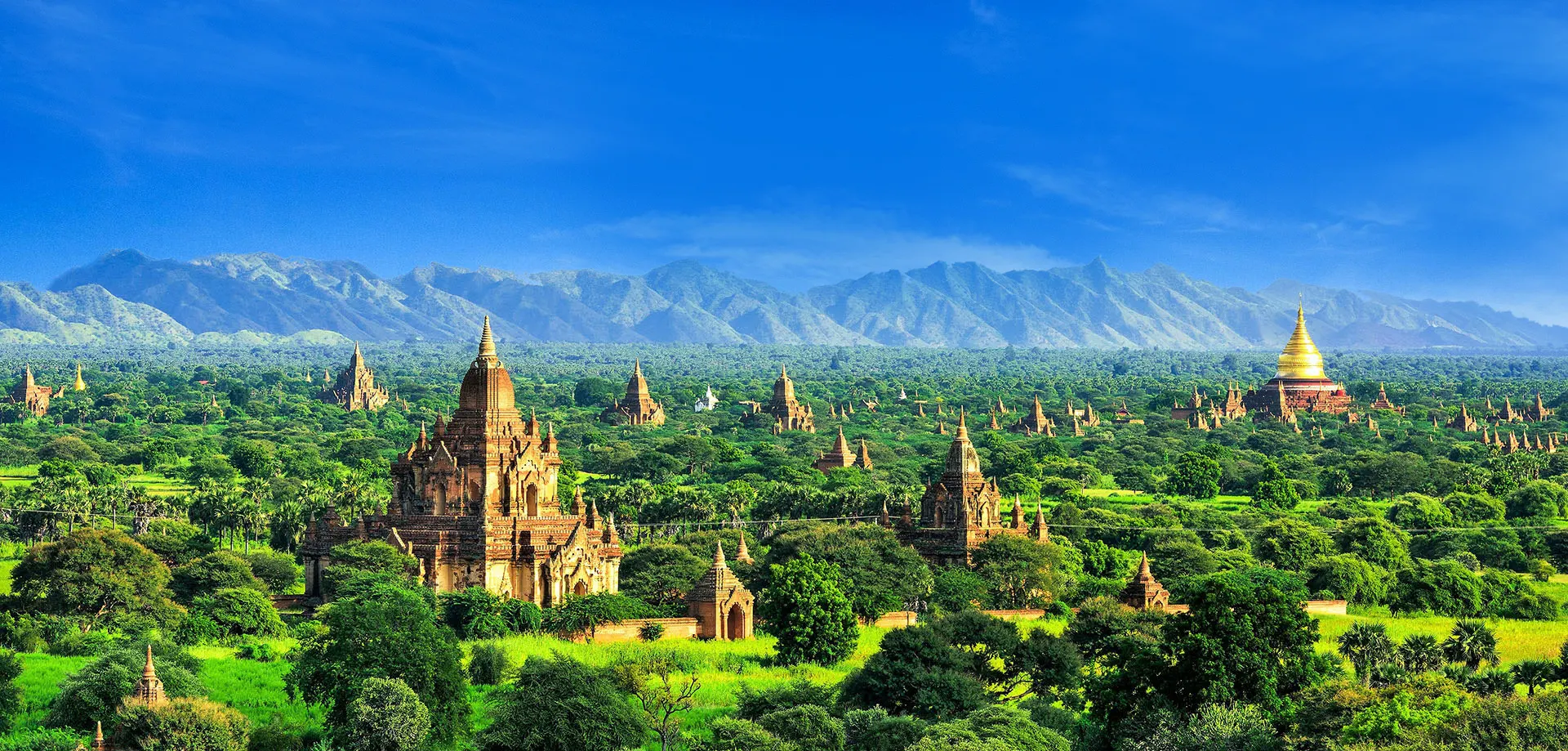
Bagan Landscape
The landscape at Bagan is spectacularly otherworldly, with over 3800 pagodas and temples spread over miles of lush green countryside and jungle. Some are massive and have well preserved and exquisite details; others are smaller and in various stages of disrepair.
Due to tourism related damage to the priceless structures, a few years ago the authorities ruled that no one is allowed to climb Bagan’s monuments. Start with the thousand-year-old Shwezigon Pagoda, a great example of prototypical Burmese architecture. It was built of sandstone carried from the quarry at Turintaung Mountain (seven miles away from Shwezigon) by using a chain of people. As mentioned earlier, the massive Archaeological Zone at Bagan is other-worldly and amazing photo opportunities are everywhere you turn. Adding to this charm is the fact that cowherds and goatherds can sometimes be seen grazing their livestock around these monuments, seemingly oblivious to their magical surroundings.
Next you will visit the Wetgyi-in Gubyaukgyi Temple, which was built about 900 years ago. The temple has a large collection of well-preserved wall paintings that depict scenes from the 550 jatak life stories of the Buddha. After this you will drive a short distance and visit the beautiful Ananda Temple, one of the most impressive and exquisite monuments of Bagan. It was built in 1091 A.D. and it stands out among the hundreds of ancient structures around it. The last of this morning’s experiences is the awe-inspiring Dhamayangyi Temple, the largest temple in Bagan. The craftsmanship of this temple is widely regarded as one of the best examples of precision brick work during the Bagan Era. The design of the temple is, in some ways, similar to the Ananda Temple, but on a much larger scale. Most of the interior has been walled off by the authorities.
After this temple there is a break for lunch, which can be enjoyed at a restaurant on the banks of the scenic Irrawaddy River, or at your resort. After lunch you are assisted with your check-in to your boutique resort, Bagan’s best upscale lodging, and then you are at leisure for a little while to freshen up after your early start and busy morning.
Mid-afternoon - enjoy an excursion to the striking Thabyinnyu Temple, one of the oldest structures in Bagan, and the tallest temple (217 feet, 66 meters) in the region. The temple’s size and unique white façade make it stand out from all the other monuments at Bagan. It is featured in many photos of Bagan’s landscapes.
Next you will board your horse cart and enjoy a short ride (you can also choose to be driven in your vehicle) to the iconic Shwesandaw Pagoda, the tallest (328 feet, 100 meters) pagoda in Bagan. The massive stupa has a succession of five terraces, culminating with a conical stupa. The thousand-year-old monument is purported to house some of Lord Buddha’s hair.
Day 4: Bagan – Mandalay. (Breakfast) An optional Balloon Ride over Bagan is available early this morning.
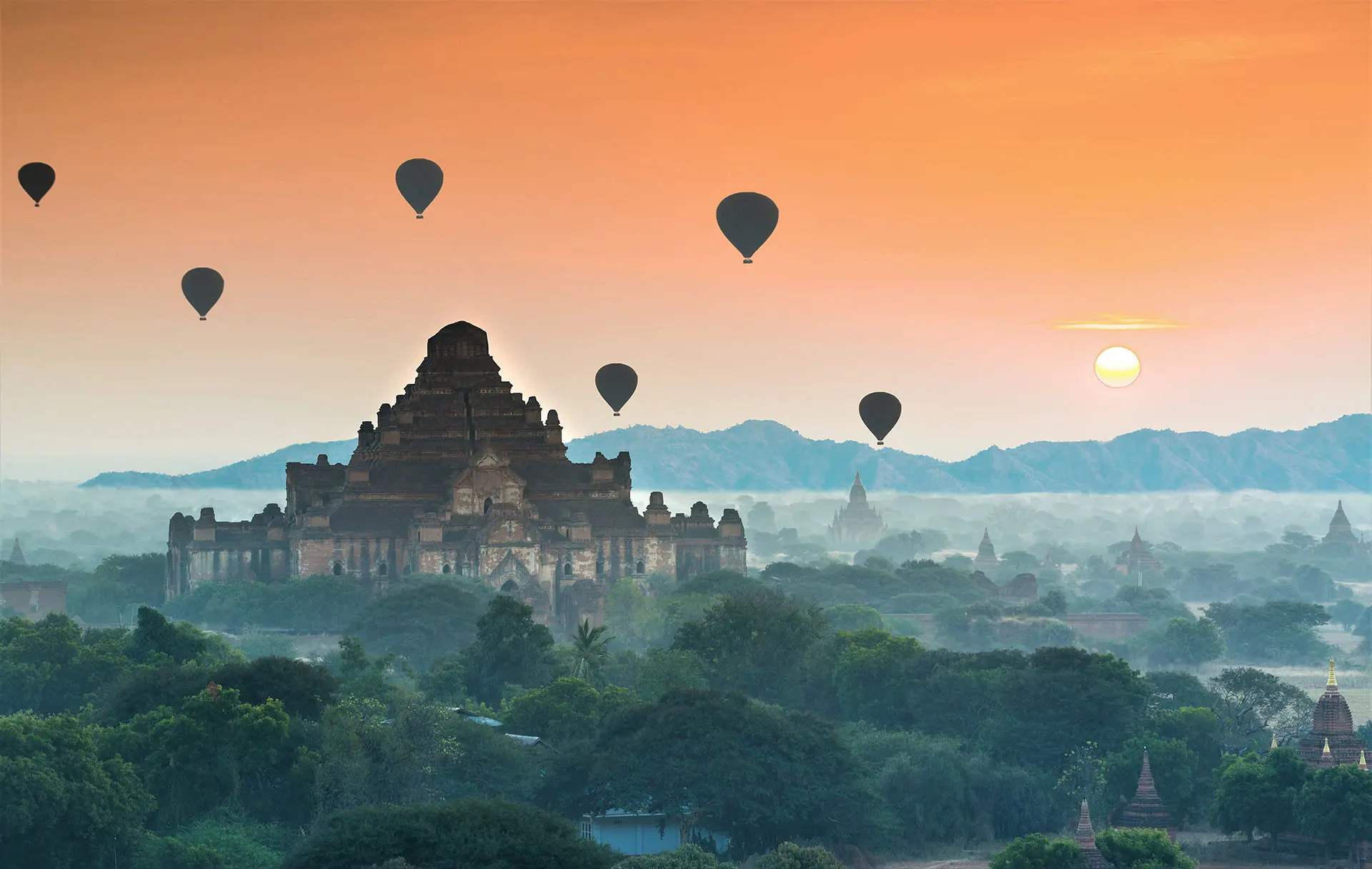
Balloons Over Bagan at Sunrise
This sunrise ride offers a dreamlike panorama of the magnificent green valley and its incredible plethora of monuments.
We use Myanmar’s best Balloon operator and this selection has to be made during your reservation process, with a surcharge of $304 per person. After breakfast, you are assisted with your check-out and then you proceed to Bagan’s oldest lacquerware workshop, where you can try your hand at one of Burma’s traditional art forms. You’ll be shown around the workshop where every phase of production, from splitting the bamboo to etching designs, are performed. - Each stage will be described in detail to give you an understanding of how this ancient craft has developed into an art form.
After this you will head out towards Mandalay, with a diversion for an excursion to Mt. Popa (4981 feet). This extinct volcano offers amazing views of the Bagan valley and the river. Lunch at the Popa Mountain Resort, while enjoying the stunning view, is strongly recommended. You can opt for the strenuous climb up to Popa Temple by the old iron stairway for even better views of the Bagan plain, but please note that this will make your arrival in Mandalay fairly late. The four-hour (approximately) drive to Mandalay is through scenic rural countryside, and lots of opportunities to view, and photograph, farming communities as they go about their daily lives. Upon your arrival you are assisted with your check-in to your suite at Mandalay’s newest, and best, upscale hotel.
Day 5: Mandalay. (Breakfast) Join Your Tour Director this morning and head to Amarapura, the 18th Century capital of Myanmar. You will now visit Myanmar’s largest monastery, Maha Gandayon. A walking tour of the monastery where well over a thousand young apprentice monks (ranging from about 6 years to early manhood) spend many years under the tutelage of senior monks will give you insights into how the young monks live in dormitories, and how their day is spent in education and prayer. You will have the opportunity to observe a fascinating ritual, the process of how thousands of daily meals are prepared to feed the monks, from their supply stores to their massive cauldrons in which the food is cooked. After this you will briefly watch and photograph as over a thousand young Buddhist monks line up, and very slowly move to the front of the line so that they can be served, and then consume their main meal of the day. Due to the crowds of camera and phone deploying tourists nowadays, and out of respect for this ritual, Easy Tours does not have our guests spend much time observing this procession of about a thousand young monks.
Out of respect for this ritual, we do not have our guests spend much time observing the procession of about a thousand young monks. In recent years the number of tourists that throng this ritual has increased significantly, and now too many people surround the dual lines of young monks so that they can take pictures with their phones and cameras.
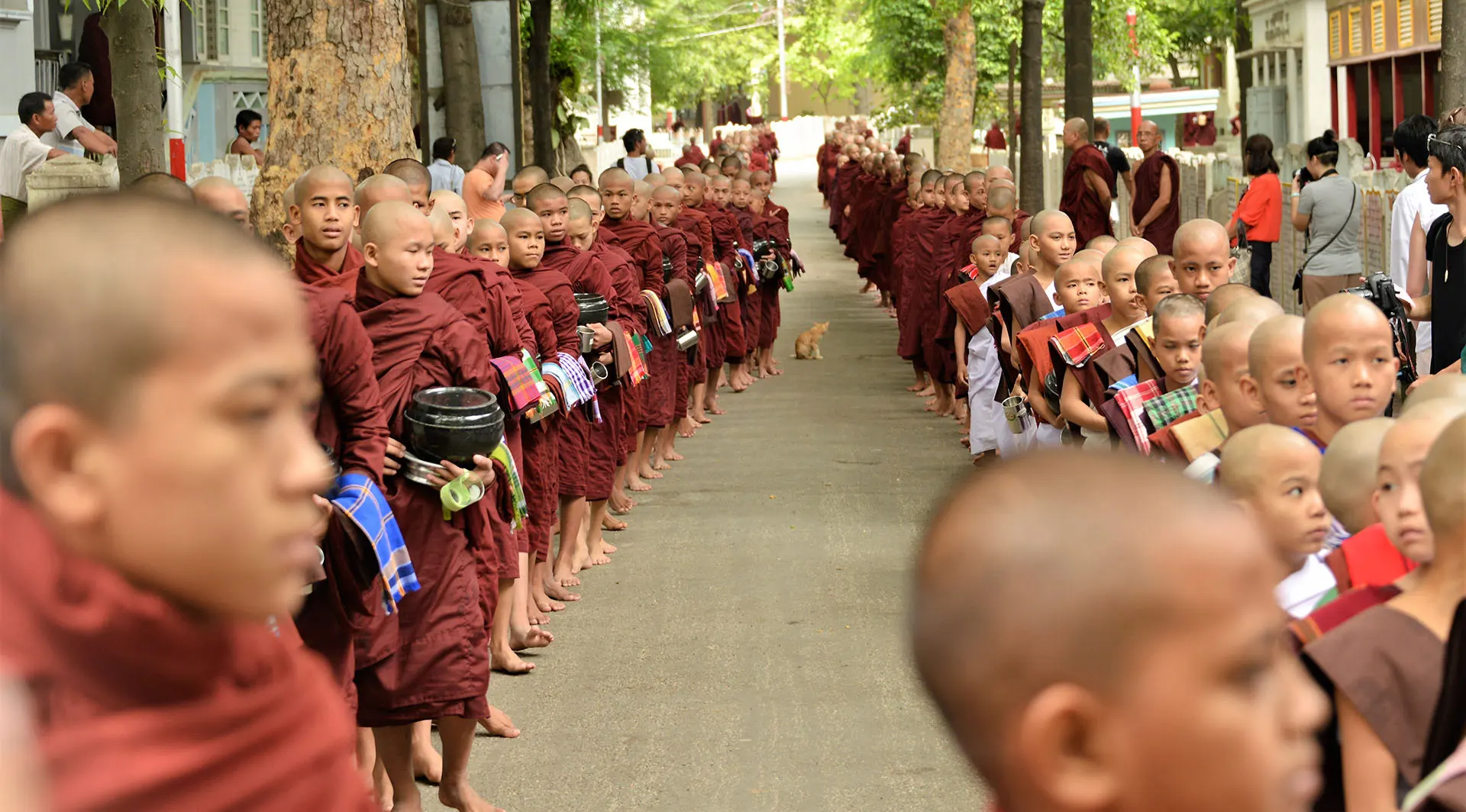
Amarpura Mandalay Lunch Line
The lunch line ritual takes about an hour before the last of the young men gets seated. Myanmar’s affluent families provide these meals and there is a waiting line of months, sometimes stretching into years, for this privilege.
While the line of young monks slowly moves up, you will move towards a different vantage point that allows you to view parts of the dining halls. Burmese families consider a monk in the family as the highest honor. You will start exploring the massive dining halls at a covered outdoor hall which will be occupied by a group of very young boys dressed in white robes. They are not part of the monastery, and are brought here by their families to get acquainted with life in the monastery.
At Amarapura you also have the option, if you so desire, to observe the local specialty, traditional silk weaving. The craftsmen meticulously design and manually create the silk garments that are worn by Burmese for special occasions like wedding ceremonies, graduation or major cultural and social events.
After a break for lunch you will cross over the historic AVA Bridge (built in 1927 by the British Occupiers, then partly damaged during WWII, before being renovated in 1954) to Saggaing. Saggaing Hill offers a panoramic view of the Irrawaddy River and the hills on the other side. After admiring the view, you are driven to the bottom of the hill and you will now visit one of Myanmar’s unique nunneries. According to local belief, the direct lineage of the women monks in Myanmar’s prevalent form of Buddhism, Theravada Buddhism, died out in ancient times. The governing council of Buddhism in Myanmar has ruled that there can be no valid ordination of women in modern times, and Buddhist nuns are not held in anywhere close to the reverence that male monks are; actually, it is quite the opposite. At the nunnery you will learn about the unique lifestyle of Burmese nuns and their beliefs, while you observe some of their daily activities.
After this you will head back toward Mandalay, and your last stop today is a very unique bridge that offers amazing photo opportunities. The 160-year-old U Bein Bridge is the longest teak bridge in the world. Enjoy a walk along part or all of the 1.2-kilometer-long bridge. Please note that the bridge is always full of locals and tourists, and so, rather than walking the whole bridge, we recommend a partial walk, and then the following sampan ride. You have the option to board a Sampan, which is a small wooden rowboat, so that you can cruise along Taung Tha Man Lake and admire the bridge from a short distance, especially as the sun sets over the horizon.
Day 6: Mandalay. (Breakfast) Start your day with a drive through the rural countryside. You will arrive at a jetty from where you will board a private boat to cross the mighty Irrawaddy. The cruise takes about an hour and you will go by tiny fishing hamlets on islands in the river. If you are fortunate, you may get to see river dolphins on this cruise, although they don’t often venture this far south on the river.
As you approach the banks on the other side of the river, you will be greeted by the sight of the massive unfinished pagoda that awaits you at Mingun village.
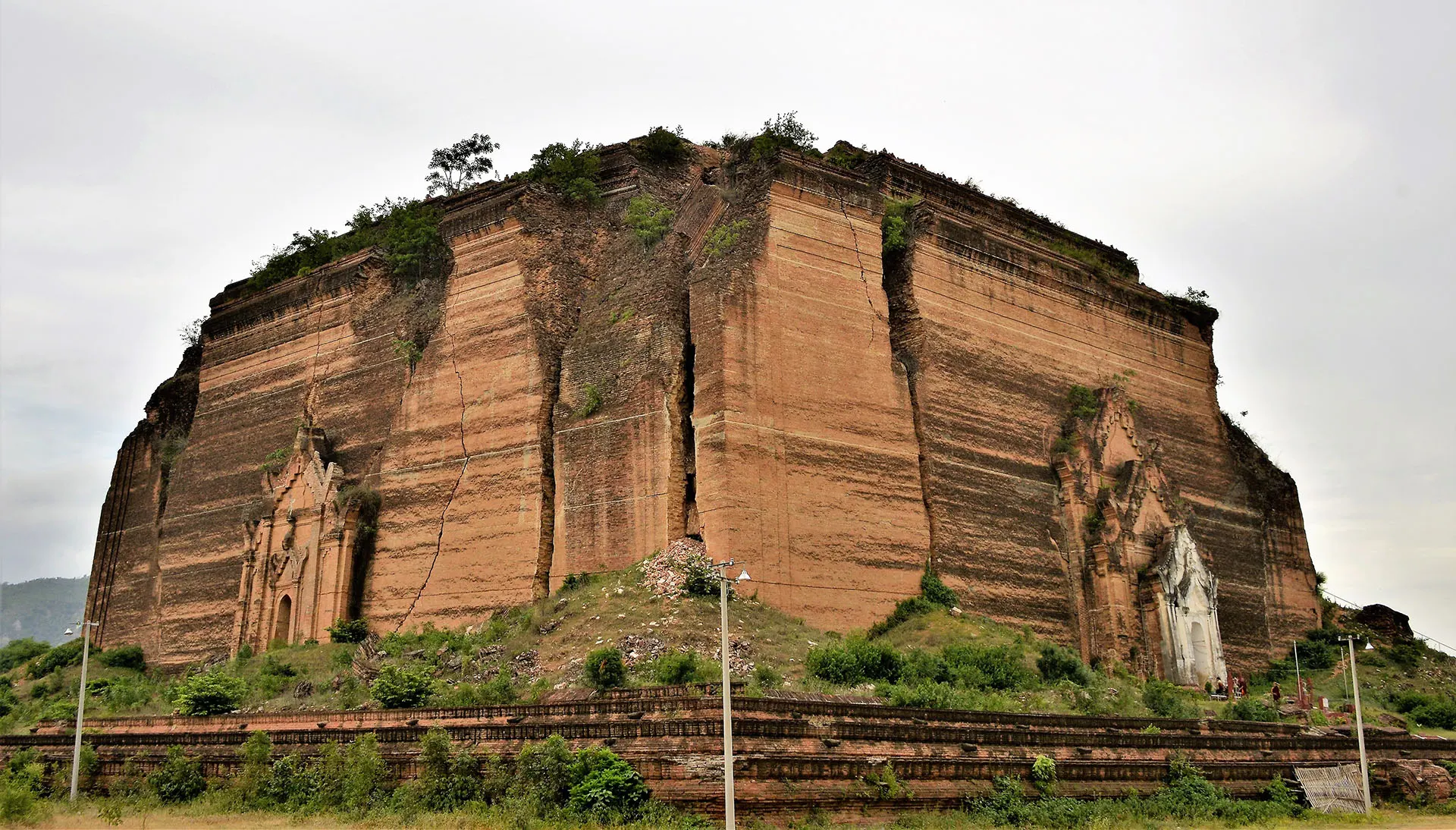
Pa Hto Daw Gyi Pagoda Mandalay
Pa Hto Daw Gyi Pagoda was started in 1790 but, due to the king’s death, construction stopped after about 20 years.
20,000 laborers were employed in its construction,and the depletion of the kingdoms reserves on its construction costs is rumored to have been behind foul play that was suspected in the king’s untimely death. The massive unfinished brick structure has major cracks that were caused by an earthquake in 1838.
The next stop on your adventure is the enormous Mingun Bell which was constructed by the same king around 1810. At 90 tons (200,000 lbs.), it is said to be the largest ringing bell in the world. After ringing the bell, which is done by hitting the sound bow with wood, you will enjoy a short village walk through the ancient fishing village and observe the lifestyles of the locals. Your last brief stop at Mingun will be at the strikingly white Mya Thein Dan Zedi Pagoda, built by the King of Saggaing as a memorial for his beloved wife, who passed away one week after giving birth to their son. This charming white structure is quite different from any other pagoda you will see in Myanmar, and the local’s call it Myanmar’s Taj Mahal. Return to the jetty for your scenic cruise back to Mandalay. Disembark at the jetty and there is a break for a late lunch.
After lunch you will enjoy a guided visit to the Maha Muni Image. This is the most sacred Pagoda in Upper Myanmar and a treasure trove of Buddhist culture.
The main Buddha statue at the temple continuously increases in size as devout Buddhist men place gold leaf on it throughout the day, as an offering to Lord Buddha. Next is the Shwenandaw Monastery, a masterpiece of wood carvings, constructed with teakwood from the palace of the last Burmese King. The incredible detail of the teak carvings is a must for visitors to Mandalay. Rulers of this kingdom had a tradition of not wasting the teak of structures that became obsolete, so they were disassembled and used for other construction.
The next experience will be the Kuthodaw Pagoda with its 729 stone slabs (housed in separate structures) of Buddha’s scriptures. This impressive complex is known as the world's biggest book. As you walk through this interesting complex, and peek at the meticulously carved slabs, you will be reminded of the simple spirituality of the Burmese people. Your last stop today is at the top of nearby Mandalay Hill, from where you will enjoy magnificent sunset views of the Mandalay region and the mighty Irrawaddy.
Day 7: Mandalay – Heho – Inle Lake. (Breakfast) You are assisted with your check out from your hotel in the early morning and driven to the airport to board the short flight to Heho. Upon arrival at Heho Airport, you are greeted by your chauffeur and then you start on the scenic 90-minute drive during which you descend from the mountains to the amazing Inle Lake region. Upon your arrival at Nyaung Shwe Village, the main access point to Inle Lake, you are assisted to the jetty where you will board a boat for your journey to the heart of the lake.
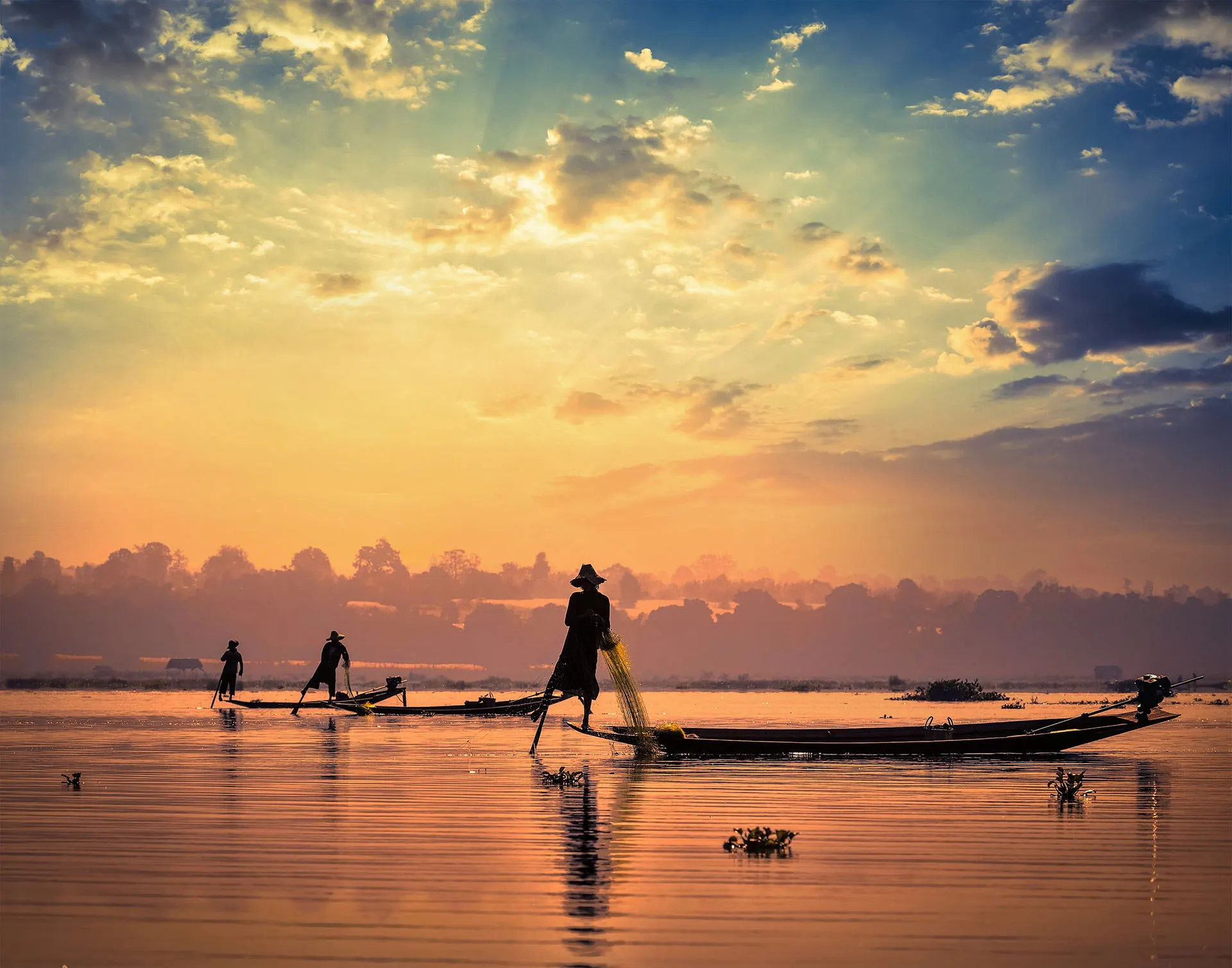
Fishermen on Inle Lake
This journey will serve as your introduction to life in this aquatic region as you go past scores of boats that the locals use to transport their agricultural produce.
Inle Lake is almost 14 miles long and over 10 miles wide, with an average depth of 20 feet. There are 64 villages, whose inhabitants reside on the lake in their homes that sit on stilts above the water. The incredible floating cultivation process that takes place on the lake has to be seen to be believed. Millions of pounds of vegetables (with tomatoes being king) are grown here every year and shipped all over Myanmar. Everywhere you turn there is amazing scenery and examples of the unique local lifestyle.
During your explorations at Inle you will frequently be cruising through many fascinating floating villages. There are over 100 monasteries on the lake, and you can opt to start your exploration of Inle Lake with a visit to Nga Hpe Kyaung, the Jumping Cat Monastery. This is a unique (for this region) teak monastery with tall beams supporting the roof and teak Buddha statues.
After exploring the monastery there is a break for lunch at one of the boutique restaurants that offer great views of the lake, or you can have your boat take you to your luxury lakefront resort, again the best upscale lodging in Inle, and have lunch before you are assisted with your check-in. Your suite has a large terrace overlooking the lake. After freshening up you can either enjoy the facilities and views of your resort or continue exploring the lake and the local culture with your Tour Director.
Day 8: Inle Lake. (Breakfast and Lunch) If a floating market is scheduled in your resort’s vicinity this morning, you have the option to visit it. Not including the possibility of the market, your first adventure today is the Indein village, which is both a fascinating journey and a rewarding destination. After cruising through much of the lake and many photo opportunities of fishermen and lake life, you will enter a picturesque canal at the edge and navigate your way to this ancient village. Hundreds of pagodas, many of which are crumbling, are clustered in the picturesque complex. These ancient structures are said to have been built by one of the kings from the Bagan era. You will also enjoy a walk through the bamboo forest, then a gentle climb up the stairways to the hill, which offers a magnificent view over the lake.
An exotic Lunch is served on a converted rice carrier boat in the middle of Inle Lake. The boat has been transformed for formal dining, and each course of fresh gourmet local cuisine is manually rowed by charming local ladies to your servers from the kitchen boat a short distance away. Enjoy the amazing scenery as well as your food and wine.
After lunch you will visit Phaung Daw Oo Paya, which is the Inle regions most auspicious Buddhist site. Housed in this beautiful temple complex are five small gold 800-year-old Buddha statues and a steady stream of worshippers graces the sanctum. The locals have been applying gold leaf to these statues for centuries and the figures are no longer identifiable as the Buddha as we usually see him. Later in the afternoon you will enjoy a visit to Inpawkhon village where you can observe a traditional weaving Mill.
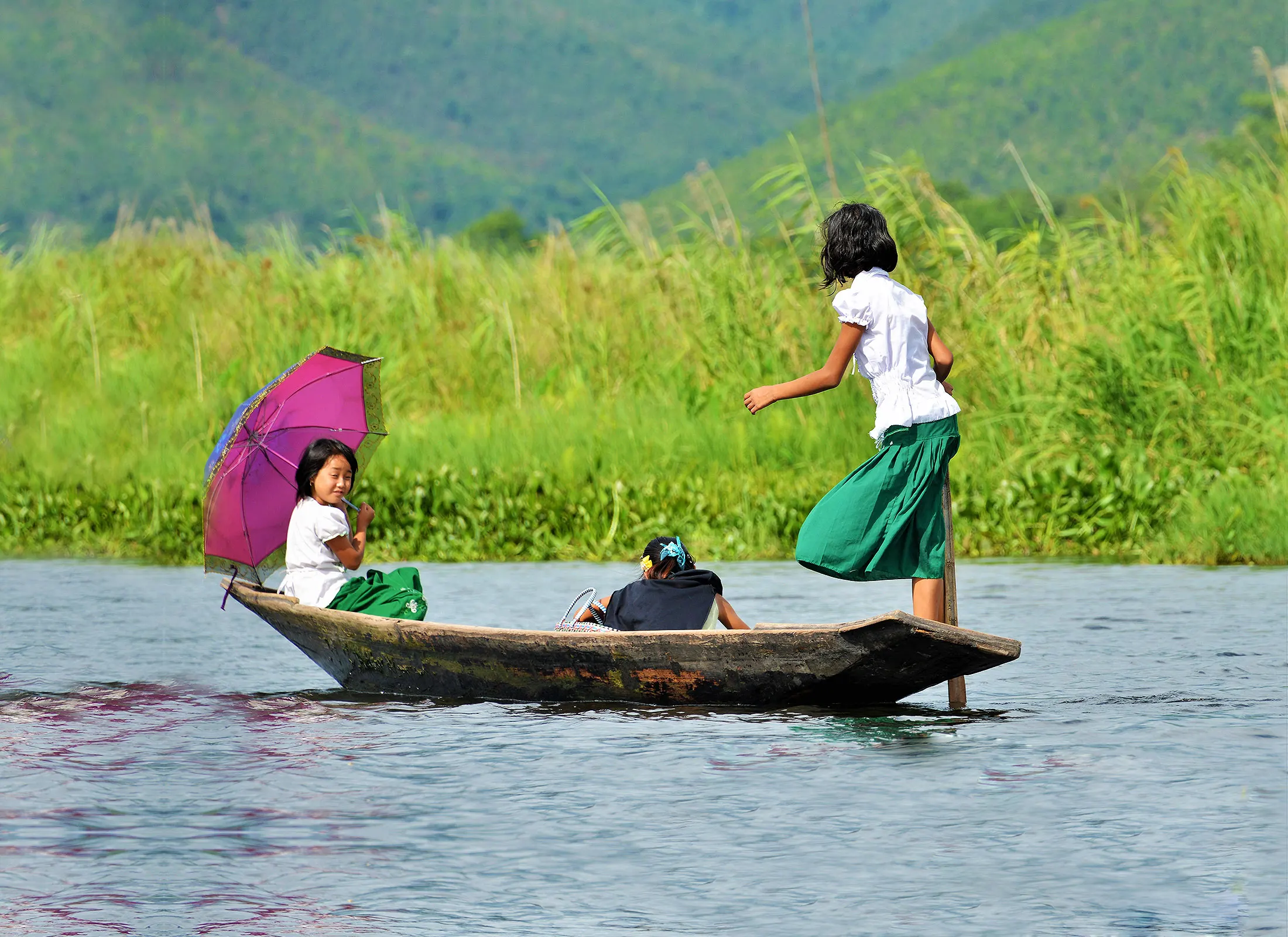
Returning from School on Inle Lake
After that you will cruise through nearby Nam Pan Village and get a close up look of people who seldom touch dry land. It is not unusual to see a 5 or 6 year old rowing their own boat around the village; the children here learn how to row soon after taking their first steps.
This afternoon’s stops will include, if you like, a visit to a facility where they make Shan paper, which is made of mulberry bark and transformed into Shan umbrellas and other beautiful local products. At the end of the afternoon you will return to your resort.
Day 9: Inle Lake – Yangon – Hanoi. (Breakfast) You are assisted with your check-out in the early morning and your boat will now take you back to the jetty at Nyuang Shwe, where you will disembark and proceed on the scenic mountain drive back to Heho airport to board your flight to Yangon. Arrive in Yangon and explore more of Yangon this afternoon, breaking for lunch at a time of your choice before returning to the airport to board your evening flight to Hanoi. Bid farewell to your Myanmar Tour Director at the airport, where you will be introduced to your VIP Airport Concierge and then be escorted through all departure processes.
You are greeted at the Hanoi airport by your VIP Airport Concierge as you disembark your plane and you will now be escorted through the complete arrival process, including immigration, baggage claim, and customs. Your Airport Concierge will escort you and then introduce you to your Travel Facilitator or your Accompanying Tour Director for Vietnam, who will usher you to your vehicle. You are then driven to your boutique luxury hotel and assisted with your check-in.
Your historic luxury hotel is the only such lodging in this city and its elegant interior is a delightful French-Vietnamese presentation of art, focusing on its earlier incarnation as the home of opera stars and visiting dignitaries. It has an enviable location in the iconic Old Quarter of Hanoi, and major attractions, great restaurants, cafes and bars, as well as the vibrant street scene, are just a few steps away, but not in any way intrusive. Hanoi is one of the world’s most fascinating cities to explore on foot, with an exceptionally vibrant street food scene, and its Old Quarter is always abuzz with activity and has an amazing energy that is near impossible to resist.
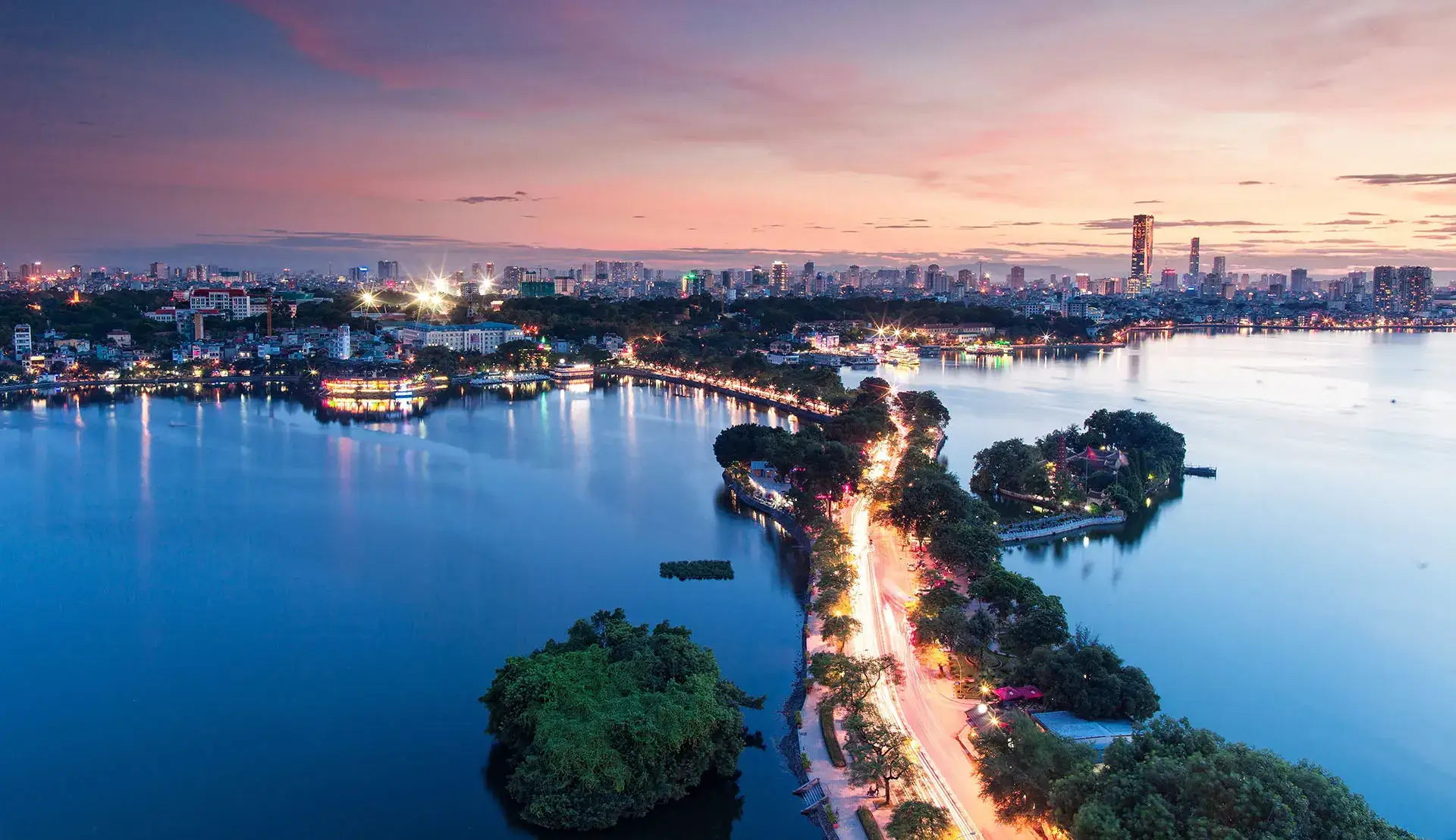
Sunset in Hanoi
Located on the banks of the Red River, Vietnam's capital is a stylish and gracious city that retains a unique old-world charm and has some of Asia’s most striking colonial architecture.
Day 10: Hanoi. (Breakfast) Start your exploration of Vietnam’s capital with a visit to the Temple of Literature. Built in 1070 as a Confucian temple and school, this complex became Vietnam’s first university six years later. Multiple courtyards, water tanks, temples, and unique architecture are what you will notice first. A unique sight here is 82 large stone slabs (with large tortoise shaped bases of stone) that have the names and other details of doctoral laureates of the university from 1442 to 1779. It is common to see local students at the temple in school groups throughout the year, and large groups of them are here dressed in their finest during graduation periods. Walk around the complex and its gardens and explore several temples housing beautiful statues of the university’s founders and greatest scholars.
Next up is the impressive Ho Chi Minh Mausoleum complex. This site is highly revered by the North Vietnamese, and consists of several structures, including Uncle Ho’s (Ho Chi Minh) modest house on stilts, and of course the iconic mausoleum itself. This granite structure stands prominently above the parade area and grandstand at a height of 70 feet and is surrounded by meticulously maintained lawns and gardens. Please note that we do not recommend viewing the preserved body of Ho Chi Minh, housed inside, as this requires a 45 minute (minimum) wait in line, and no photos are allowed.
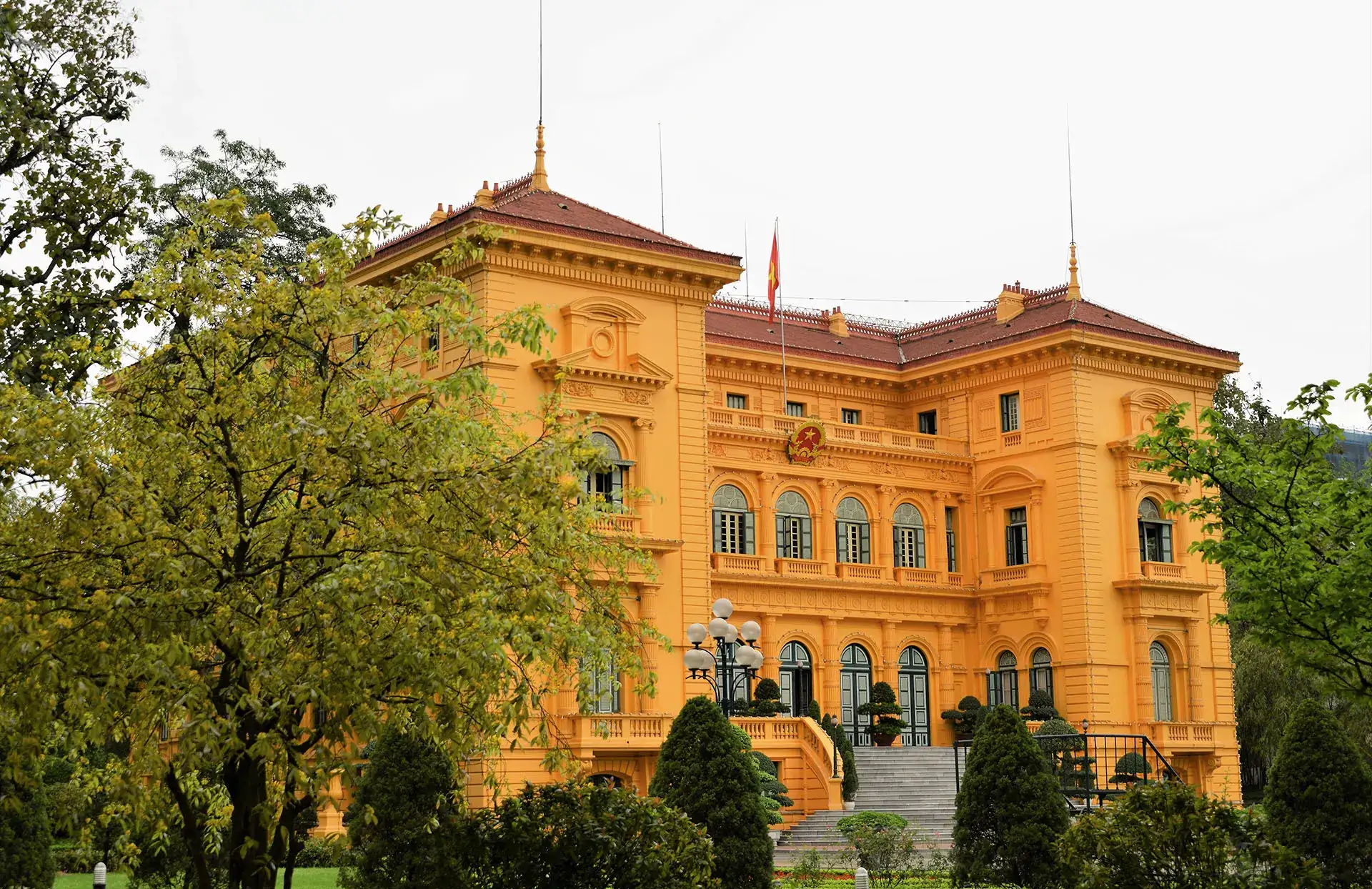
Presidential Palace Hanoi
Next to the mausoleum is the beautiful Presidential Palace, built between 1900 and 1906 as the French Governor General of Indochina’s residence. The Palace is not open to the public, but you can stop here for a photo opportunity of the front left profile of the structure, as well as its beautiful gardens.
Ho Chi Minh refused to live in the palace and had a simple home on stilts built in the gardens, which you will walk through to admire its simplicity and austerity.
Return to the old quarter and break for lunch. After lunch you will experience a guided walk through the fascinating old quarter. When Hanoi was much smaller, this area was the residential, commercial, and manufacturing hub. Each street was dedicated to locals practicing a particular trade, and this practice has continued until today, except the fact that there are far more street food outlets and cafes, adding even more color to an already fascinating sight. Your Tour Director will walk you through streets such as Hand Dong street (copper wares street) Hang Tre street (bamboo wares street), and so on. Some streets have names referring to trades no longer practiced, such as Hang Buom street (sails street), and are now focused solely on Vietnamese candy and cakes. There are streets full of flower decorators and sellers, and many of the streets still have temples, pagodas, and communal structures from old times.
Day 11: Hanoi. (Breakfast) Start your day with a visit to a residential Hanoi district seldom experienced by foreigners. You will feel like you have traveled back in time into the 1960’s when Hanoi was a quaint capital populated mostly by modest workers. Wander around these narrow alleys covered in colorful market stalls, observe the locals as they go about their daily lives – you will experience Hanoi as only the locals do.
Return to the Old Quarter and after a break for lunch you will enjoy a cyclo (pedicab) ride around the Old Quarter. These ancient narrow streets are bustling with people and shops. Your ride ends at Hoan Kiem Lake in the city center.
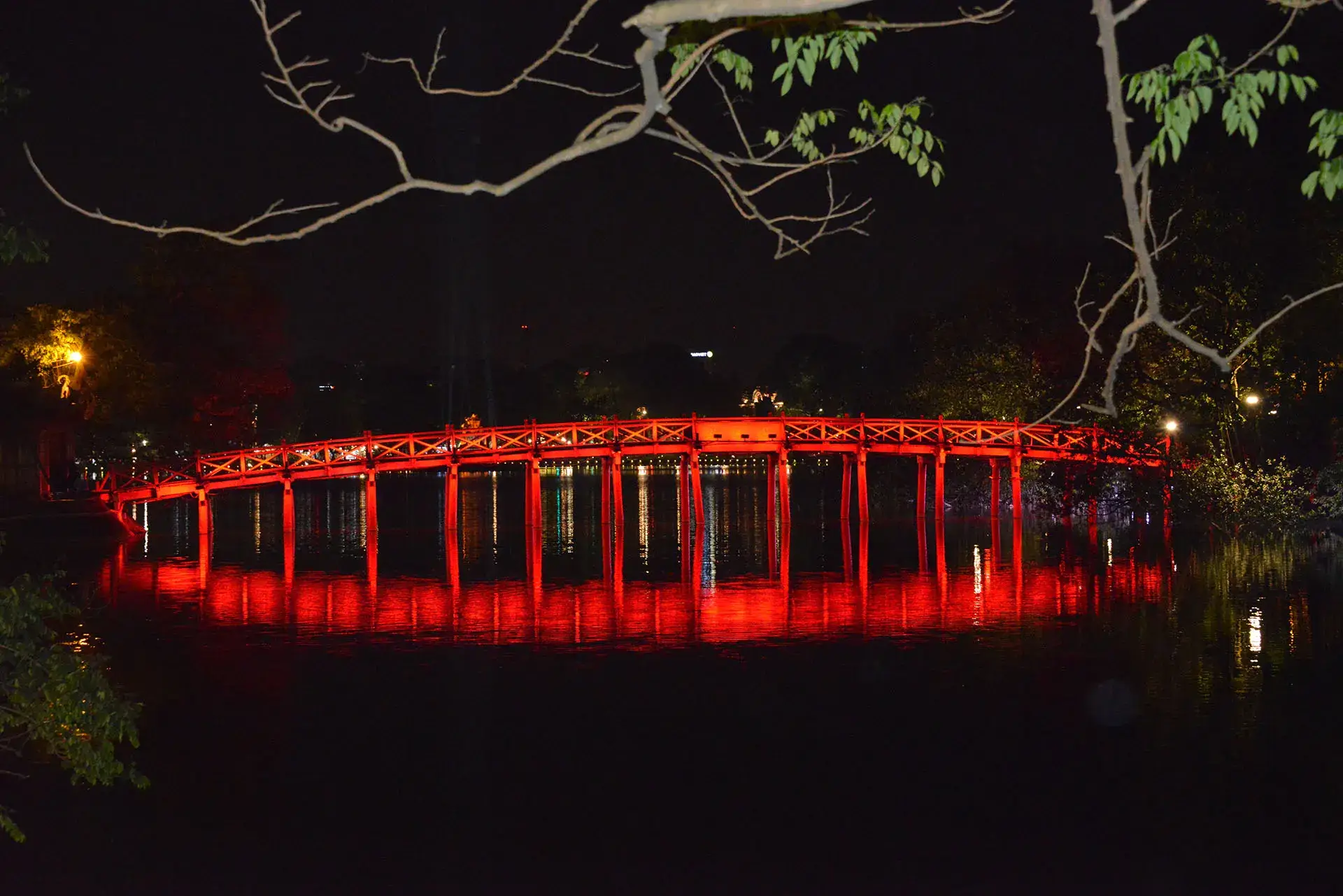
Hoan Kiem Lake Bridge to Ngoc Sun Temple
The small urban lake is also known as The Lake of the Restored Sword, and the area surrounding it is Hanoi’s cultural center. Visit Ngoc Son Temple, situated on a small island in the photogenic lake, and observe the fascinating rituals that take place here - the devout visit it throughout the day.
In the early evening comes a fascinating performance of Water Puppetry, where our guests will enjoy preferred seating. The Thang Long Puppet Theatre is Hanoi’s most famous because of the quality of the performers, and it is located on the banks of Hoan Kiem Lake, across from Ngoc Son Temple. This art form, which is unique to North Vietnam, originated in the 11th century. The combination of indigenous music, small fireworks, and the colorful wooden performers, as well as the accomplished musicians visible in the gallery, makes this spectacle a great introduction to North Vietnamese culture.
After the performance, you will enjoy a short walk to your hotel by the charming lake, walking past the locals as they dine on street food, an activity that is omnipresent at night all over the Old Quarter. By now you will start realizing that the Vietnamese take street food to a whole new level, even by Southeast Asia standards – people eating are everywhere, occupying sections of the pedestrian walkways, parks, sometimes taking over parts of the roads after sunset, enjoying the wares of scores of small street stalls.
Day 12: Hanoi – Haiphong - Ha Long Bay on Orchid Cruise. (Breakfast, Lunch and Dinner) Check-out from your hotel in the morning, and then you are driven 1.5 to 2 hours to Haiphong, a significantly shorter drive than to Ha Long, where almost all other cruises start. Upon your arrival you will join your fellow cruise travelers in a reception area where refreshments will be served. After a while you will be assisted in boarding your small luxury cruise ship which has among the largest cabins among the boats plying on Ha Long Bay. You will be in an upgraded balcony cabin with fabulous views.
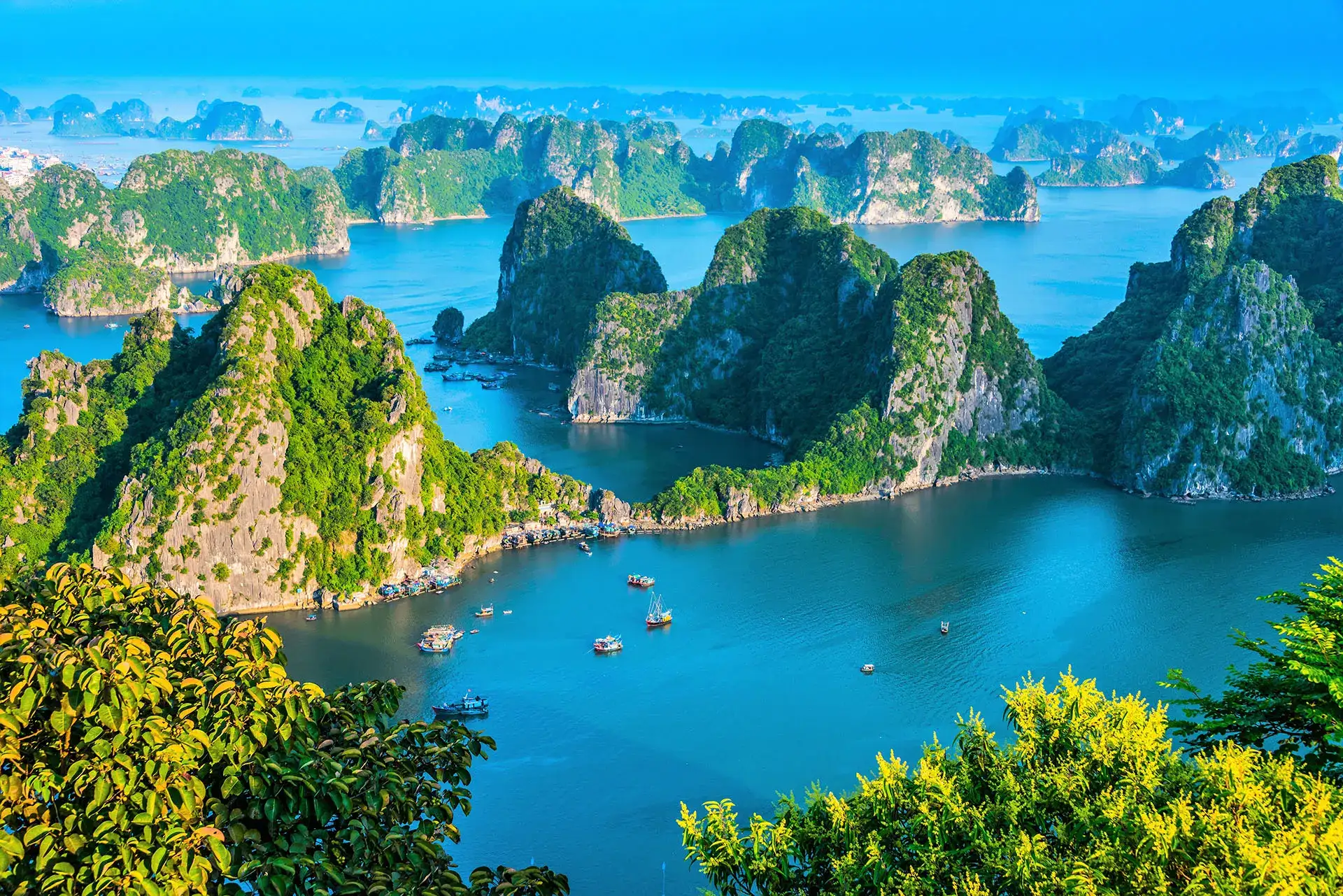
Halong Bay Arial View
The entire bay is classified as a UNESCO World Heritage Site and is one of the world’s most spectacular seascapes.
The water is relatively calm on the bay, and the scenic beauty is characterized by a vast area that is full of lush limestone (karst) hills jutting out of the ocean. A buffet lunch is served shortly after the cruise begins. Your cruise will visit some of the main attractions of Ha Long Bay that are also visited by other boats, but you will also spend quite a bit of time where most other cruises don’t go, in stunning locations that are a little off the beaten track.
You will have various excursions available during your cruise, including options to canoe, swim, explore amazing caves, and there will be a full schedule of activities on the ship that you can participate in. Very good Vietnamese and western cuisine options will be served throughout.
Day 13: HaLong Bay – Hue. (Breakfast and Lunch) Wake up to stunning views and then enjoy a light breakfast, after which you have the option to experience this morning’s scheduled excursion.
Return after the scheduled morning excursion, and a full brunch will be waiting for you. The boat now begins its leisurely cruise to the dock, giving you plenty of time for more relaxation and photographic.
Check out of your cabin and you are met by your Tour Director and chauffeur at the dock. You are then driven to Hanoi airport to board your flight to Hue, The City of Mist.
We feel that, in terms of history and culture, Hue is a more important destination than Ho Chi Minh City. Because of this and Hue’s proximity to Hoi An, we feel that tours that do not include Hue are depriving their travelers of a top tier destination.
You are greeted at Hue airport and you are driven to your art deco historic riverfront resort for check-in. By far Hue’s best lodging option, it was the residence of the French Resident Superieure in times past, and you have an upgraded suite since the rooms are rather small. Hue is known for its magnificent monuments built under the Nguyen Dynasty (1802 - 1945), and also famous for its amazing food, as well as its unique conical hats. Unlike Hanoi and Saigon, the city has a relaxed vibe, and evening walks by the Perfume River, and the delightful cafes that are found here, are highly recommended. The monuments that you will visit here make up one of Vietnam’s eight UNESCO World Heritage Sites. This honor was bestowed on the city in 1993 since it is such a fine example of an eastern feudal capital.
Day 14: Hue. (Breakfast) Your day will start in the morning with a visit to the impressive mausoleum of King Tu Duc (ruled 1848 - 1883). Close by is the next attraction, the unique mausoleum of King Khai Dinh (ruled 1916 - 1925).
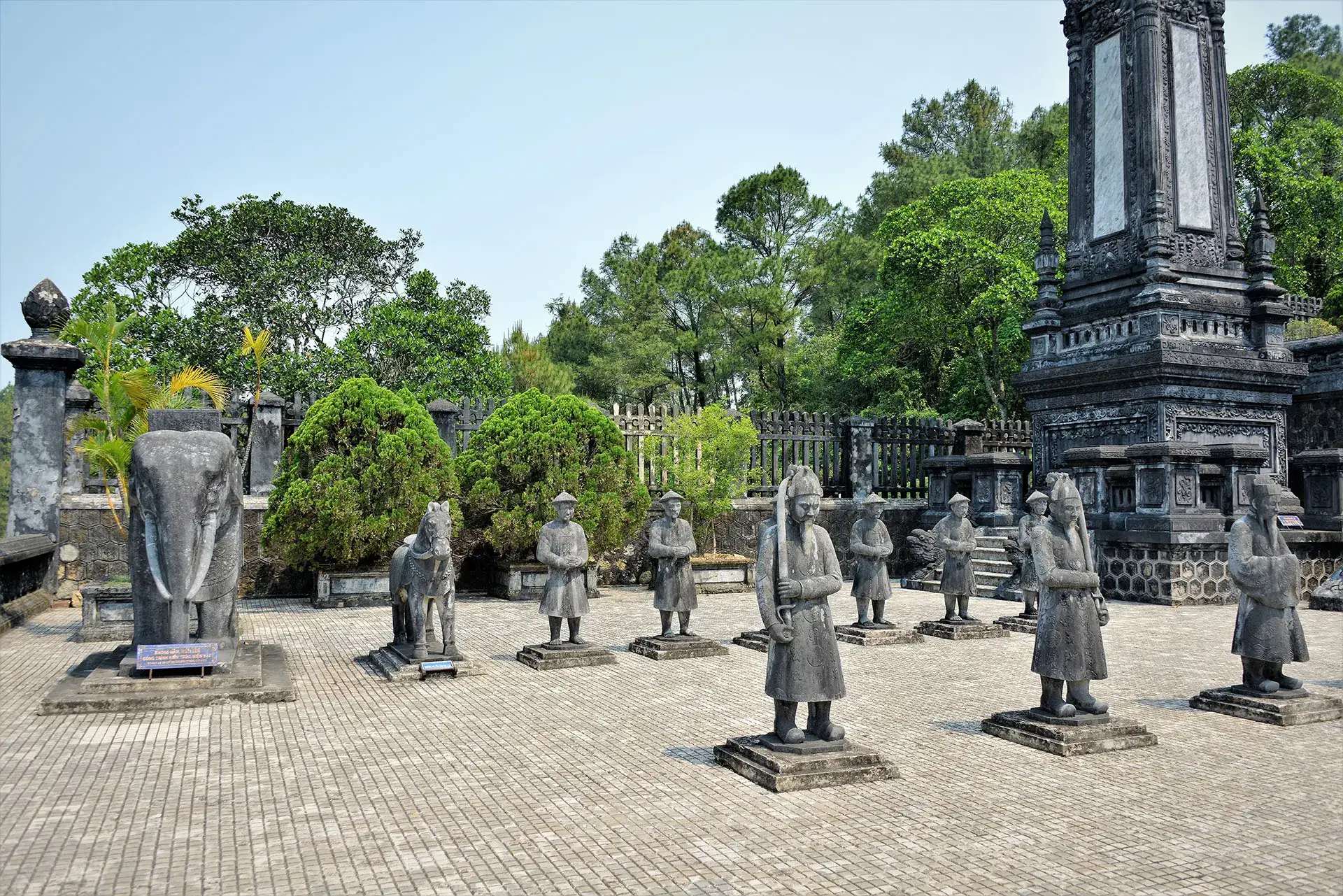
A Courtyard at King Tu Duc's Mausoleum
These ornate and colorful monuments, designed by the kings themselves, were also used as holiday retreats during their lifetimes.
Next you will enjoy a guided walk-through older parts of Hue, including a busy market located next to the river. After a lunch break you will continue your exploration with a visit to the Royal Citadel. The sprawling complex of palaces, fortifications and pagodas was, in its day, virtually impenetrable. The tour of this Imperial City features monuments such as the Flag Tower, Noon Gate, Nine Dynastic Urns, Nine Holy Cannons, Thai Hoa Palace (Palace of Supreme Harmony), and the Forbidden Purple City.
Day 15: Hue – Hoi An. (Breakfast) You will be assisted with your check-out in the morning. Embark on a scenic 3.5-hour (approximately) drive to Hoi An. Some of this drive is through coastal fishing villages, and much of it is on one of Southeast Asia’s most spectacular roads, where you straddle the Pacific Ocean with amazing views on one side, and lush green hills on the other.
At the highest point of the journey you will have a breathtaking view of the Pacific, and on the other side a view of the modern city of Da Nang and its bay.
You will drive through the outskirts of Da Nang as you head towards Hoi An, and a brief photo opportunity stop will be at the beach zone that was a favorite for American soldiers during the Vietnam war, immortalized in the television series China Beach.
Arrive close to Hoi An in the early afternoon, in time for a slightly late lunch, and you will check-in at your gorgeous luxury oceanfront resort. Some tour operators lodge their guests at modern and crowded casino resorts in the Da Nang region, about an hour from Hoi An. We prefer the Four Seasons Nam Hai, which is located just a short drive from Hoi An, with one of the finest beaches in Vietnam. This is luxury in the truest sense, with large villa’s designed for privacy, incredible cuisine, amazing service, multiple gorgeous pools, and a lot more. Although many of our guests ask for beach time at the end of their touring, it is definitely worth it to consider adding a day or two here, which we will be happy to accommodate upon request.
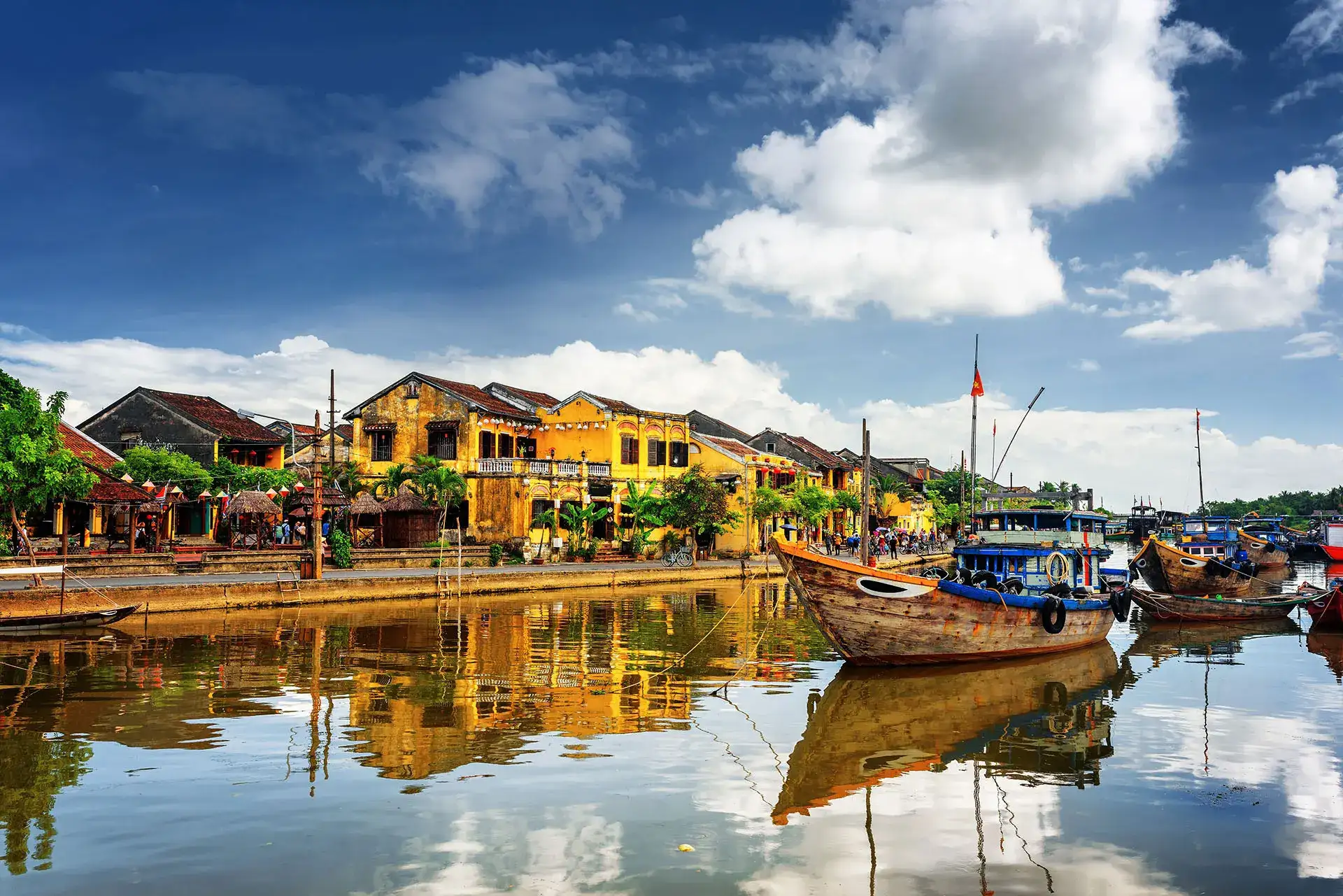
Hoi An
Hoi An is classified as a UNESCO World Heritage Site as the best-preserved ancient seaport in Southeast Asia.
We prefer not to take our guests to the ancient town during the late morning and early afternoon as, during those hours, it gets really crowded and noisy due to a large influx of tourist bus groups from the Da Nang resorts. However, guests who would like to, can have their Tour Director take them right after lunch. We recommend beginning your discovery of the ancient seaport in the late afternoon with a guided walk through the Japanese and Chinese Quarters of the tiny town.
One of the highlights is the beautifully crafted and much-photographed Japanese Bridge. You will also visit a number of temples, pagodas, communal houses, traditional shops, and other places of interest in the small town. You can either head back to your resort in the early evening, or, those who want to continue experiencing the ancient town this evening can then have dinner at one of the delightful cafes and restaurants located on the river – the better restaurants have a distinctly French ambiance.
Day 16: Hoi An. My Son Sanctuary Excursion OR Fisherman and Farmer for a Half Day. (Breakfast and Dinner) You have two options for the first part of this day, or you can choose to enjoy one of the world’s finest beach resorts and relax. This decision needs to be made soon after you reserve your tour.
Option 1: My Son Excursion. Join your Tour Director for an excursion to the UNESCO World Heritage Site of My Son Sanctuary. These remarkable structures lie about an hour away from Hoi An, and the structures go back as far as the 4th Century. It is one of the most important examples of Hindu influence in Southeast Asia. Although largely in a state of ruin today, My Son is often compared with other historical temple complexes in Southeast Asia, such as Angkor Wat of Cambodia or Ayutthaya of Thailand.
You'll be given a brief introduction to Cham history and culture, and its Hindu influence, and then you will visit the remains of the carefully crafted red brick temples replete with beautiful monuments and epitaphs. Return to the Nam Hai and you are at leisure for a couple of hours for lunch and relaxation at your resort, until your bamboo platform dining experience.
OR
Option 2: Rural Farming & Fishing Life Experience. Join your Tour Director for a drive into the rural region away from modern civilization, along the Thu Bon River and its gorgeous Nipa Mangroves, passing lush farms and jungles. Soon you will arrive at the home and workshop of a local bamboo craftsman.
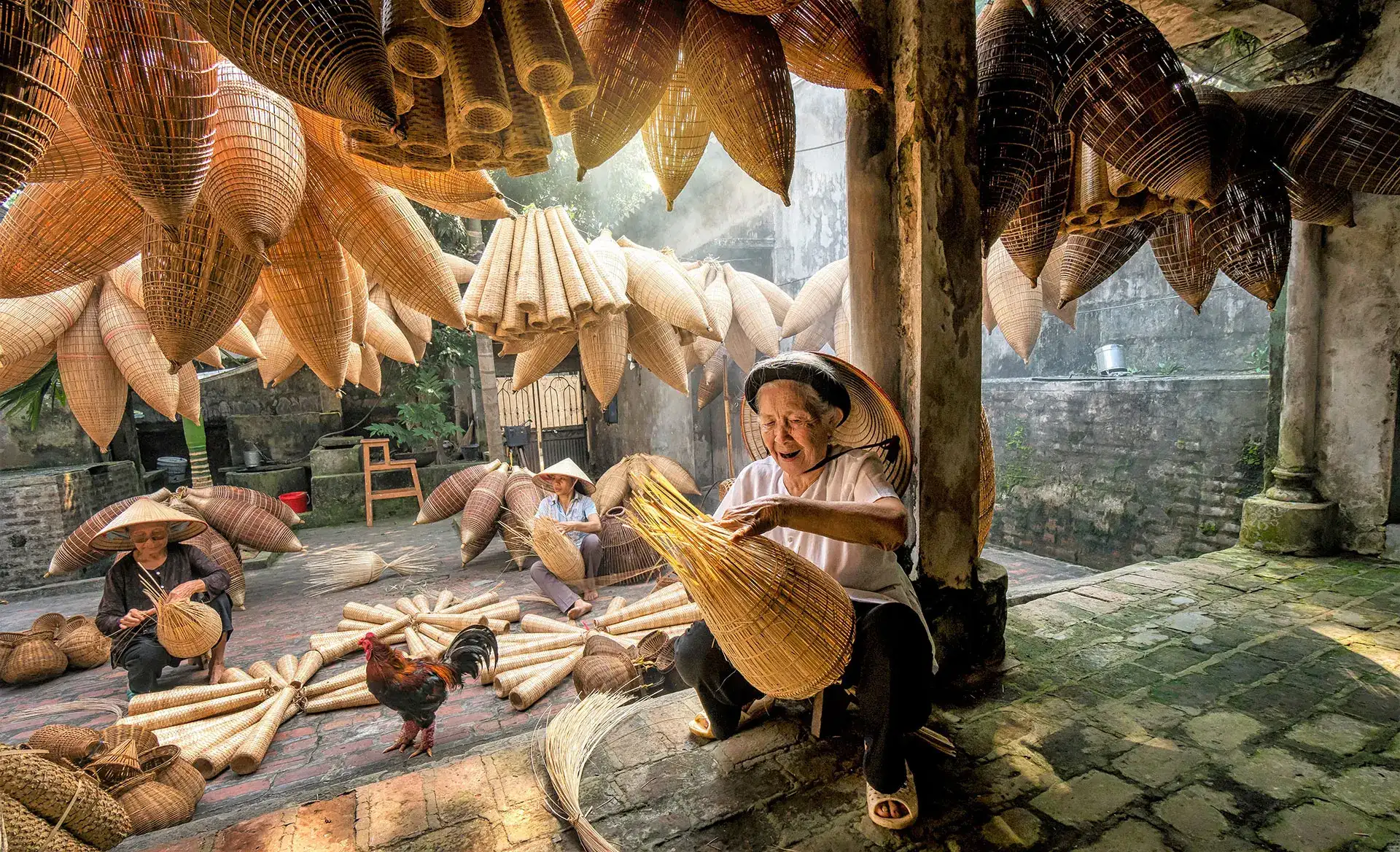
Bamboo Weaving
Bamboo is widely used for a myriad of purposes in central coastal Vietnam, and there are a few expert craftsmen who sculpt and create with this amazing natural resource.
Your host this morning is one of the very best of these craftsmen. You will be shown the steps of the creative process, and you are encouraged to make a souvenir for yourself.
You will now proceed to visit a local fisherman’s family. We recommend that you use bicycles for this part of the excursion, although your vehicle will be headed to the same destination. The approximately 5-mile ride is on flat country roads with no traffic, and the scenery is extremely charming. At the end of the ride you will meet the friendly family and learn about their simple lifestyles, followed by a lesson in Vietnamese net fishing!
A very short drive after this will end at an organic farm, where again you will learn from the farmers on how they cultivate their crops. Enjoy some of their herbal tea and snacks, and then, if you so desire, participate in their daily activities for a little while.
From here you are driven back to your gorgeous lodging and you are at leisure for a couple of hours for lunch and relaxation at your resort, until your bamboo platform dining experience.
Bamboo Platform Dining Experience: At 4:30pm your Tour Director will escort you to the banks of the river. You will be assisted in boarding one of the Hoi An regions iconic basket boats for a short cruise. After a few minutes you will arrive at your destination – a large floating bamboo raft, situated on a beautiful secluded part of the river, surrounded by tropical nature. Butlers and other staff will feed you unique local cuisine and fresh vegetables. At the end of the evening, at about 8pm, you will be driven back to your resort.
Day 17: Hoi An – Da Nang – Saigon. (Breakfast) Check-out of your resort in the morning and you are driven to Da Nang airport where you will board the noon flight to Saigon. Upon arrival, there is a break for a late lunch if you so desire, as airplane food will have been served on your flight.
From the airport area you can go directly to your lodging in Saigon, or proceed to Cu Chi, located in the countryside north of Saigon – this decision will need to be made soon after you reserve your tour. This area is famed for its elaborate network of over 200 kilometers of three-story underground tunnels hand-dug by local people during the Vietnam War.
You have the option to experience climbing down into a tunnel and crawling around to get a taste of how the North Vietnamese soldiers (Viet Cong) lived during the latter part of the war. There are displays of weaponry that was used, as well as life-sized statues of the North Vietnamese soldiers depicting the lives they lived.
After this experience you are driven to Saigon where you are assisted with check-in at Vietnam’s most luxurious city hotel, the Reverie, also ranked as Saigon’s top hotel. You are in the heart of Saigon’s downtown (District 1), and restaurants, bars, and shopping are right at your doorstep, as are historical structures such as the Opera House. Located near the mouth of the Mekong, this city was once nothing more than swampland inhabited by a few Khmer people. Today it is Vietnam’s largest and most metropolitan city, with its official name - Ho Chi Minh City.
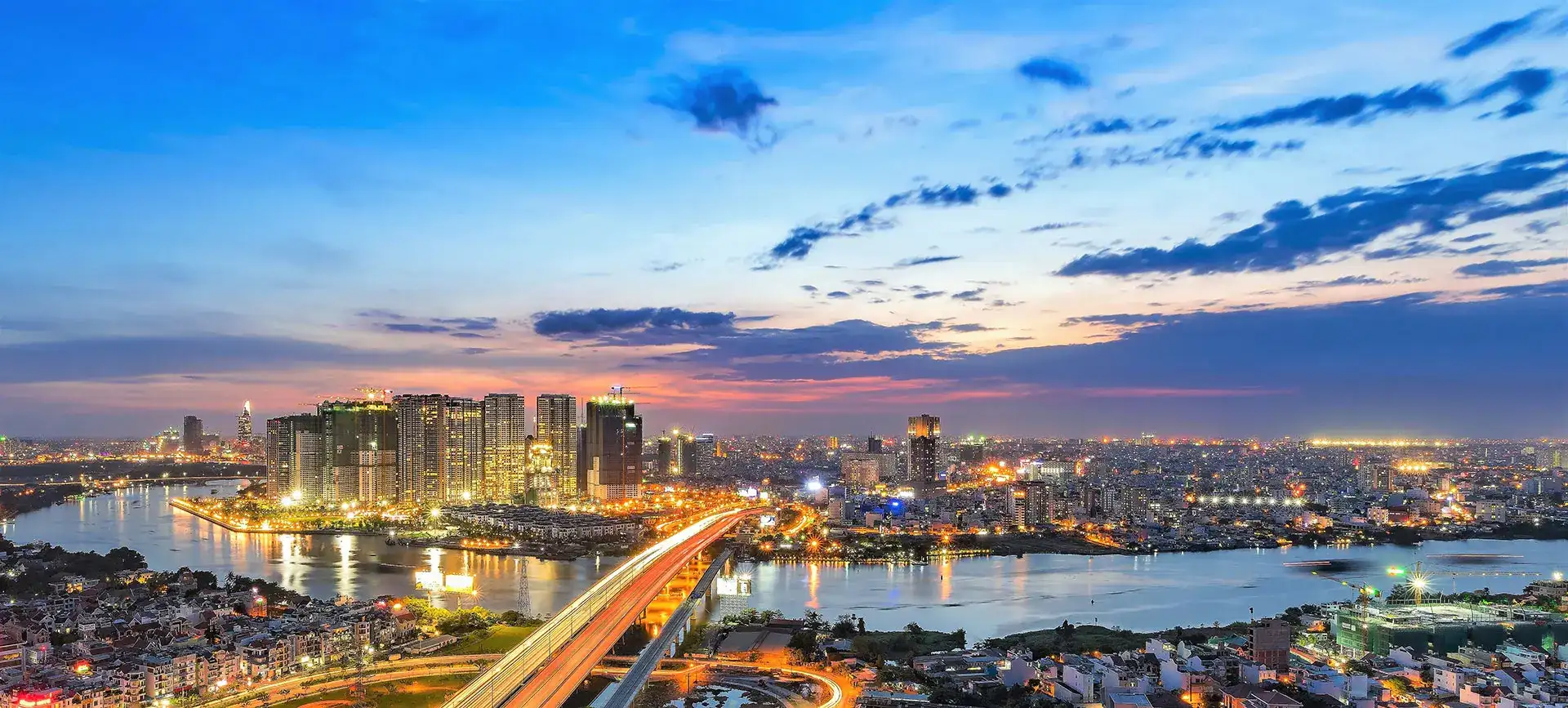
Ho Chi Minh City Sunset
The city of over 9 million people is a prototypical large Asian city with an impressive modern skyline overlooking busy streets overflowing with, for western visitors, chaotic scooter, motorcycle and other traffic.
Day 18: Saigon. (Breakfast) You will start your day in the morning with a visit to the Reunification Palace. This was the headquarters of the United States supported South Vietnamese government and has been left largely as it appeared on the day the Viet Cong’s tanks crashed through the gate and claimed victory for the North. The original furniture, equipment rooms, and war rooms remain untouched, all the way down to the rotary phones on the desks and strategic maps on the walls. In the middle of the crowded city, this large structure and its vast grounds are a fascinating time warp taking you back to the early 1970’s.
Next, enjoy a visit to the beautiful colonial building housing the Central Post Office, with its amazing collection of century old western telegraphs and other machines. This is an active place of business, and the gorgeous antique interior includes wooden phone booths and counters that the locals will be standing at while buying services.
After lunch you will enjoy a walk-through Saigon, including the famous shopping street of Dong Khoi. The walk starts at Notre Dame Cathedral and leads you to the Municipal Theater, after which you are driven to your spectacular hotel to enjoy lunch and the amazing facilities for a little while.
Brewery and Local Dining Experience: In the evening you will join your Tour Director for a short walk to Pasteur Street and the most famous craft beer taproom in Vietnam. Meet the brewer, learn about the marriage between this western practice and local ingredients, and sample several brews. You will then walk a little further to a nice outdoor restaurant located on the rooftop of an old apartment block. Dinner will be a diverse assortment of delicious Vietnamese home cooked favorites, and your hosts and Tour Director will answer any questions that you may have about the ingredients and flavors of the dishes being offered.
Day 19: Saigon - Siem Reap, Cambodia. (Breakfast) You are assisted with your check-out in the morning and you will take a short drive to the War Remnants Museum. We do not recommend this museum to guests who might get upset by gruesome war photos, descriptions, and exhibits. Also, please bear in mind that the atrocities exhibited are those attributed to American soldiers, during what Vietnam calls the American War. For those that want to forego the museum, you can enjoy your spectacular hotel until the mid-morning or explore surrounding District 1 with your Tour Director.
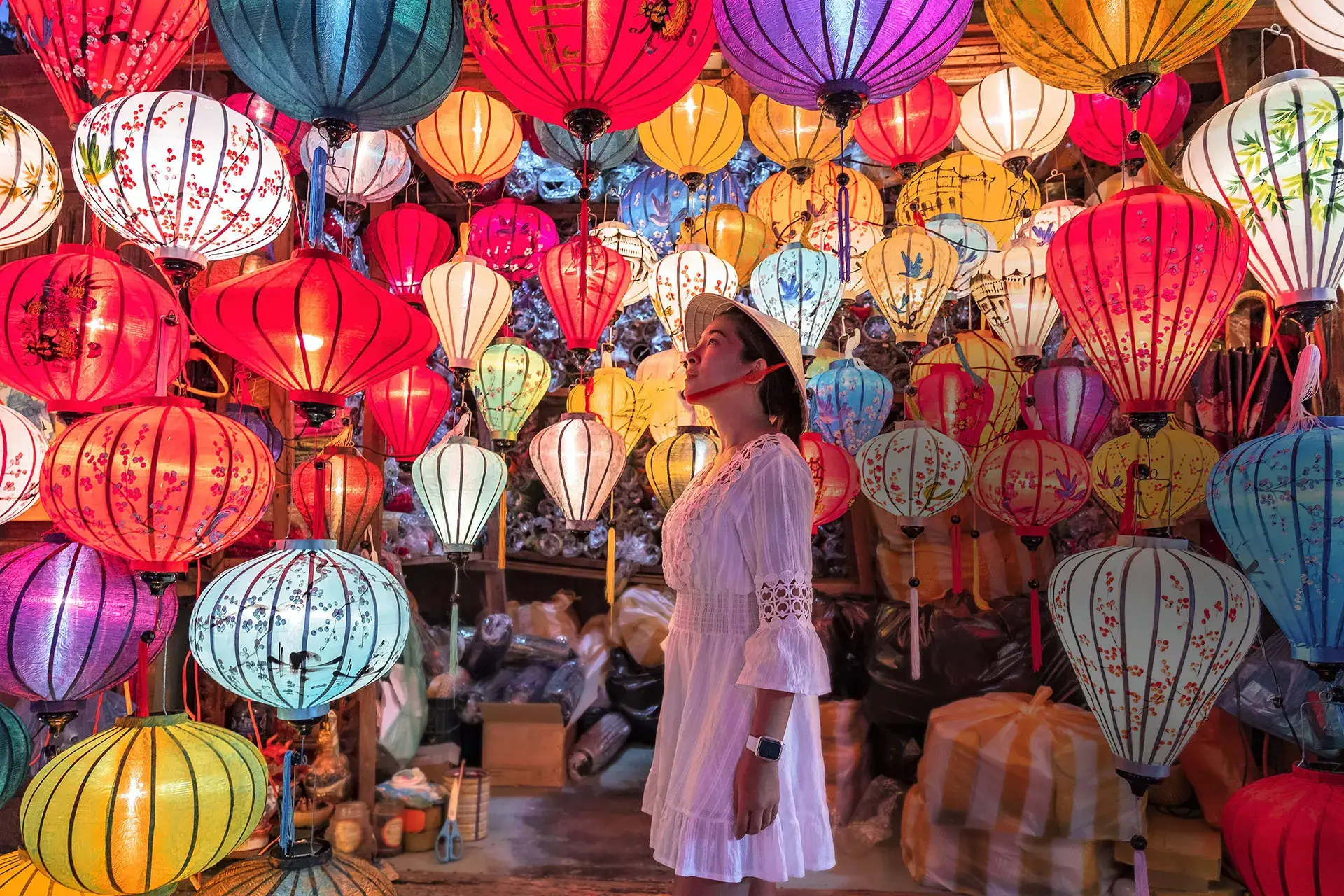
Paper Lanterns
In the mid-morning you will be driven to the colorful and interesting Binh Tray Market, where the locals come to shop for produce, fruit, poultry, meat and seafood.
After a walk to explore the indoor market, you will return to Saigon’s downtown, where we recommend a slightly late lunch at the highest rated upscale Vietnamese restaurant in Saigon, Vietnam House. After lunch you are driven to the airport where your Vietnamese Tour Director will introduce you to your VIP Airport Concierge, bid farewell, and then you will be escorted through all departure processes and assisted in boarding your flight to Siem Reap, Cambodia.
Arrive in Siem Reap and you are greeted at the airport by your VIP Airport Concierge as you disembark your plane and you will now be escorted through the complete arrival process, including immigration, baggage claim, and customs. You are then driven to your choice between the two lodging options we offer here, which are by far the best luxury boutique lodging options in the Siem Reap region, and assisted with your check-in. We initially only offered the Phum Baitang by Zannier Hotels, a gorgeous boutique resort set among lush farmland and pastoral scenery. The paddy fields around you are unobtrusively busy during the day and allow you to observe Cambodian farmers going about their daily life. Since the completion of its comprehensive renovation just before the arrival of the pandemic, you can also ask us to arrange your stay at the historic Raffles Grand Hotel d’Angkor, a beautiful French Colonial masterpiece.
Day 20: Siem Reap. (Breakfast) Rising well before dawn, proceed for your exploration of the most famous temple in Southeast Asia, Angkor Wat. Believed to be the world's largest religious building, this 12th century temple is a perfect fusion of symbolism and symmetry and a source of pride and strength to all Khmers. Arrive at the monuments entrance before the sun rises and walk to a location near the temple, where your sunrise view of Angkor Wat is across lotus ponds. This is the best time to visit Angkor Wat because it is the least crowded during the early morning, and watching the sunrise over the awe-inspiring complex is an experience not to be missed.
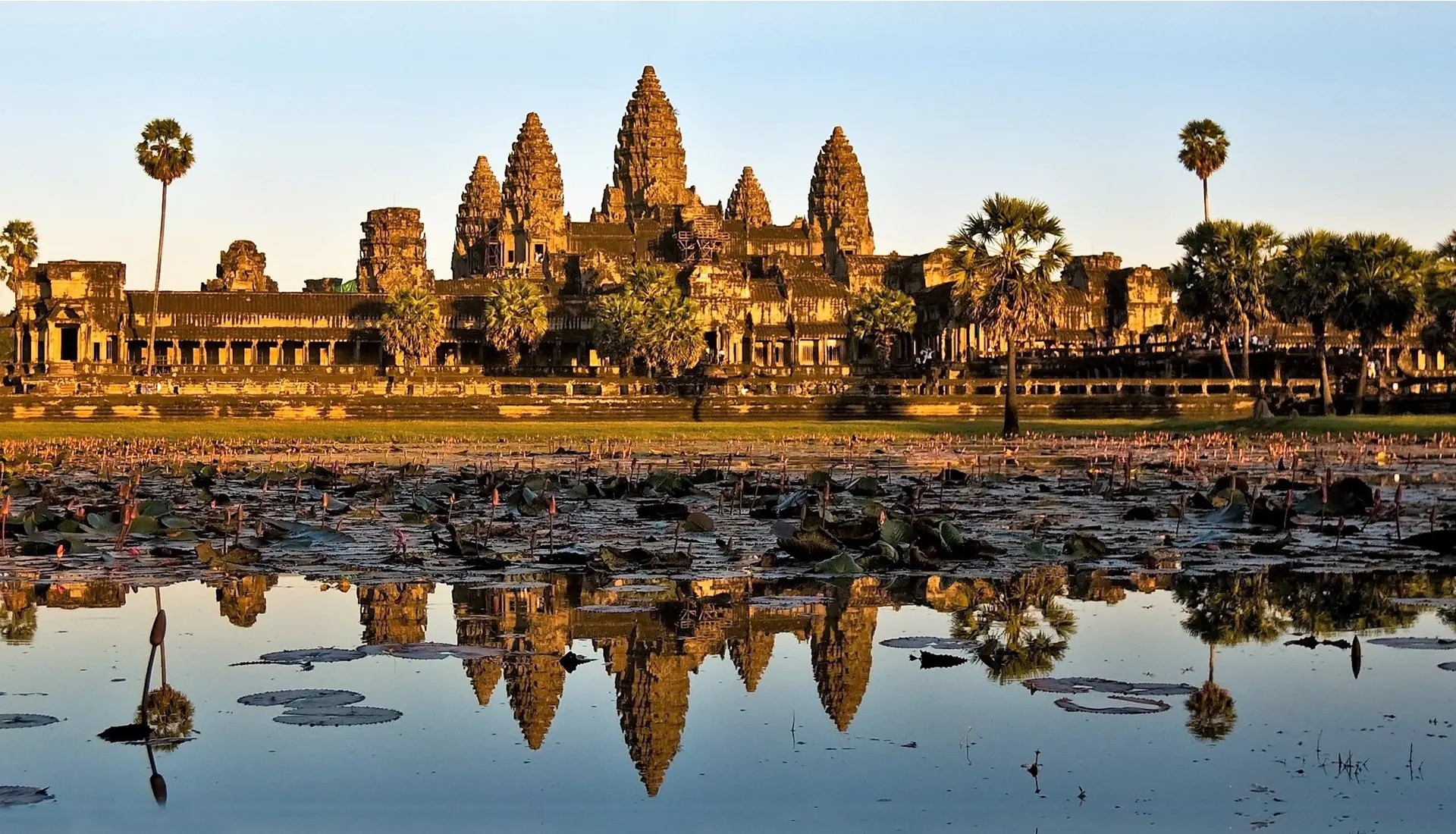
Angkor Wat
After admiring the sunrise, you will proceed into the massive complex to discover its incredible structures and plethora of intricacies, which will be highlighted by your Tour Director.
After exploring Angkor Wat you are driven back to your resort for some time to freshen up and to have breakfast. In the late morning you will explore the immense walled city of Angkor Thom and its multiple awe-inspiring monuments built at a scale that is simply amazing. Following the occupation of Angkor by the Chams from 1177 to 1181, the king decided to build an impregnable fortress at the heart of his empire.
The causeway is lined by an intricate bridge depicting the Churning of the Ocean of Milk from Hindu mythology in which the Devas (gods) and Asuras (devils) are engaged in tug of war with a Naga (seven-headed serpent) to obtain the elixir of immortality. Next up is the enigmatic and enchanting temple of the Bayon. At the exact center of Angkor Thom, this is an eccentric expression of the creative genius and inflated ego of Cambodia’s most celebrated king. Its 54 towers are each topped off with the four faces of Avalokiteshvara (Buddha of Compassion), all of which bear more than a passing resemblance to the king himself.
There is a break for lunch after which you will visit mystical Ta Prohm, which has been abandoned to the elements. Left as it was discovered by French explorer Henri Mouhout in 1860, the tentacle-like tree roots here are slowly strangling the surviving stones. This was one of the settings for the original Tomb Raider movie. Complete your exploration of this section of Angkor’s wealth of monuments with a visit to another temple that makes you feel like you have traveled back in time - Preah Khan. This large temple has also been left unrestored for the most part and is a fascinating maze of narrow passageways and windows that each offers their own unique view into the past.
Day 21: Siem Reap. (Breakfast) Join your Tour Director for a very scenic 75 to 90-minute drive through the Cambodian countryside to the amazing temple complex of Beng Mealea. Arrive and start your exploration of this massive early 12th century complex.
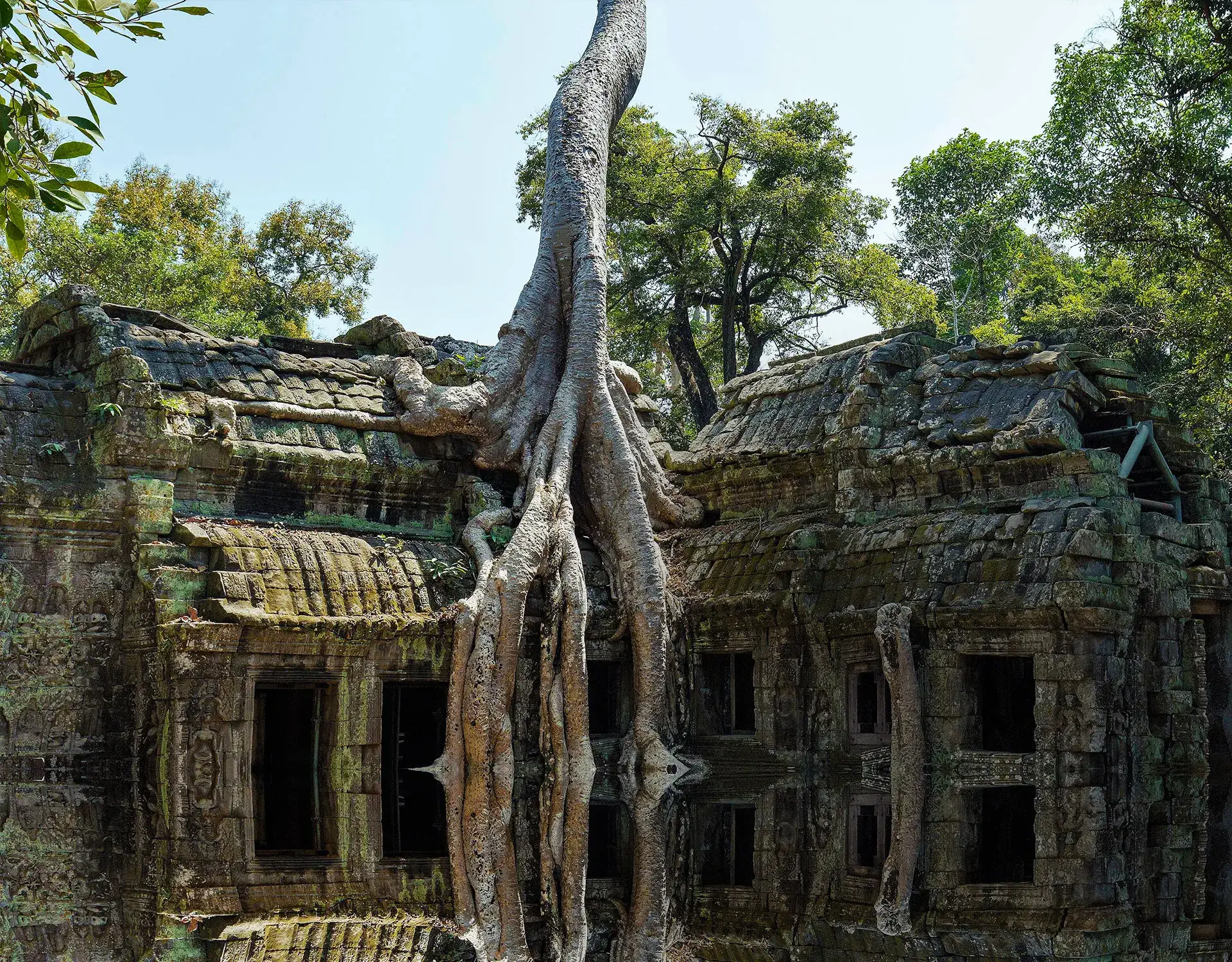
Beng Mealea Tree
Although partially in ruins, much of the complex is still in good condition, and some of the trees and vegetation have intermingled with the structure to create a sight that is unmatched by other similar monuments in Southeast Asia.
Due to its distance from Siem Reap, this surreal complex attracts significantly fewer tourists than Angkor Wat and the temples in the city of Angkor Thom. From Beng Mealea you will head towards Tonle Sap stopping for lunch along the way.
Tonle Sap Lake is the largest freshwater lake in Southeast Asia, the lake is connected to a river of the same name. A UNESCO Biosphere Reserve, the area is one of the most biodiverse in the world, and its waters were what sustained the magnificent Angkor civilization, and others before that. The lake loses much of its water during winter, and when the rains come in the late spring/early summer, the lake fills up and rises over 30 feet. You will board your boat and explore the lakeside fishing community of Kampong Khleang, the largest town on the lake, and no doubt be impressed by the network of houses on up to 30-foot-tall stilts, lush farmlands, and small fishing communities. You will have the opportunity to observe how the locals live and work in this unique environment. Unlike the very touristy and hawker-filled village of Chong Kneas, where almost all other tours go, Kampong Khleang offers a more authentic experience.
Evening: Join your Cambodia Tour Director for a fascinating walk through the local night market where tourists and locals shop for all sorts of items, while enjoying street food.
Day 22: Siem Reap – International Flight. (Breakfast) After checking-out you will head to the Banteay Srei Temple Complex. Although it attracts more visitors than Beng Mealea, it is less crowded than the main complexes in the Siem Reap Region. Banteay Srei is another Cambodian temple dedicated to the Hindu God Shiva, and, at more than a thousand years of age, it is older than almost all of the more significant temples in the Siem Reap Region. Constructed from hard Red Sandstone, this complex is a study in detail. It is small when compared to the main complex’s structures in Siem Reap, or even the Beng Mealea Complex. However, the intricacy of its original sculptures, especially the detailed figures of Hindu Gods and Goddesses, and the voluptuous and beautiful Apsaras, is unsurpassed even among all the wonders found in the Angkor region. Some parts of this temple, more so than in other Angkor Region monuments, are replicas due to theft over the last few decades, before adequate protection was added.
From Banteay Srei you will head, stopping along the way for a slightly late lunch, to the Siem Reap airport, where you will be assisted in boarding your international flight. Bid farewell to your Cambodia Tour Director at the airport, where you will be introduced to your VIP Airport Concierge and then be escorted through all departure processes. Please note that international flights have check-in requirements that require you to be at their check-in counter approximately 2.5 to 3 hours (for coach), and 2 hours for premier classes, before that flight departs. If you used Easy Tours advice/assistance for your international flights, we would factor in the above.
Our services will end at the airport.
Lodging
| Yangon |
The Rosewood Yangon – Grand Heritage Room with River View Terrace
|
| Bagan |
Aureum Palace Bagan Hotel – Jasmine Orchid Lake View Villa
|
| Mandalay |
Pullman Mandalay Mingalar Hotel – Deluxe Suite (Club Benefits*)
|
| Inle Lake |
Sofitel Inle Lake Myat Min – Opera Lake View Suite with Terrace
|
| Hanoi |
Capella Hanoi – Junior Suite
|
| HaLong Bay |
Orchid Cruise – Premium Suite Cabin with Balcony
|
| Hue |
Azerai La Residence Hue – Colonial Junior Suite
|
| Hoi An |
Four Seasons Resort the Nam Hai – One Bedroom Ocean View Villa
|
| Saigon |
The Riverie Saigon – Panorama Deluxe Room
|
| Siem Reap OR (Your Choice) Siem Reap |
Phum Baitang (Zannier Hotels) – Pool Villa
Raffles Grand Hotel d’Angkor – Colonial Suite |
Inclusions
| VIP Airport Concierge on all International Arrivals and Departures (6 Services) | |
| Accompanying Tour Director for Airport Assistance on all in-country flights | |
| Breakfast daily | |
| Fine Dining Experience at SEEDS Restaurant in Yangon | |
| Private Floating Lunch Boat with Gourmet Cuisine on Inle Lake | |
| All meals on HaLong Bay | |
| Ground transportation via upscale private vehicles | |
| Representative for assistance on departure / arrival transfers per the itinerary | |
| Services of the best English-speaking Accompanying Tour Directors | |
| Applicable monument entrance fees as per the itinerary | |
| Bottled water during sightseeing | |
| Hotel accommodation as listed above | |
| All Boat Fees/Fares per the itinerary |
Not Included
| International travel except countries on your Easy Tours Journey | |
| Any expenses of a personal nature, such as tips, laundry, phone calls, drinks etc. | |
| Meals other than those specified on itinerary | |
| Travel insurance, visas, etc. |

